Note
Where are the people who abused the black and white students at woolworth lunch counters in the 50's and 60's. Have any repented publicly
Good question. I was able to find and interview one of the high school students who was part of the melee and whose image was captured in the iconic photo of that scene. He never repented and, indeed, seemed to believe that he was one of the heroes that day for fighting to preserve the ‘Southern Way of Life.’ I spoke to him once again after the book came out (and only a few months before his death) and he expressed no remorse, continuing to believe that segregation was a better way for the races to co-exist. He was particularly opposed to Inter-racial marriage.
You can hear more about my interaction w/ this student on my recent appearance on “The Uncomfortable Truth” podcast: https://podcasts.apple.com/us/podcast/the-jackson-woolworths-sit-in-a-discussion-with-mike-obrien/id1498323248?i=1000533861874
#The Uncomfortable Truth#Jackson Woolworth's Sit-In#We Shall Not Be Moved#Loki Mulholland#D.C. Sullivan
0 notes
Text
Appreciation - Meredith C. Anding, Jr. (1941 – 2021) and the Tougaloo Nine
Upon first meeting, many a visitor may have been tempted to consider Meredith Coleman Anding, Jr., a reticent, almost opaque, man. Soft spoken, terse yet amiable, sphinxlike, enigmatic. Instead, he was the epitome of John Wayne’s character in The Quiet Man—with a preternatural calm on the surface, but with a fierce, almost primal determination to get what was his due: freedom and the respect that came with it. For this, he will be remembered down through the ages.
For it is Meredith Anding’s name, thanks to its alphabetical primacy, that leads the list of quiet Mississippi freedom fighters that we now know as the Tougaloo Nine. These courageous (and, by their own later admission, a bit naive) college students from nearby Tougaloo College, “stepped into history” (as Tougaloo’s former President Beverly Hogan often said of them) on Monday morning, March 27, 1961, when they calmly entered the Whites-only municipal library in downtown Jackson, Mississippi. It was the first student-led civil rights demonstration in the state, all the more remarkable because it was carried off in the Magnolia State’s capital city, under the noses of the most powerful White supremacist politicians, police force, and spy agency in the country and in an environment of intense racial segregation that had been hardening ever since the Brown v. Board of Education decision in 1954.

Meredith Anding’s Tougaloo Nine mug shot on 3/27/1961. [Courtesy Mississippi Department of Archives and History (MDAH)]
Secretly assisted and urged on by the NAACP’s “Man in Mississippi,” Medgar Evers, Anding and his cohort created shock waves of horror throughout the White community by the simple act of entering a library, selecting books from the shelves, and calmly sitting down to read. Their actions made a mockery of Jackson’s Mayor, Allen C. Thompson, who as President of the American Municipal Association had gone on a nationwide tour to tout his city’s racial amity despite its harsh segregationist strictures.
For their crime, Anding and his four male and four female colleagues were arrested for “Breach of Peace”—a newly coined law in many Southern states that allowed police to intervene if individuals were creating a situation that put someone’s peace of mind in jeopardy. When the police first arrived, they tried to persuade the students to leave on their own volition, hoping to avoid a showdown in court. But Meredith and his fellow Tougalooans ignored the pleas of the cops. Once told they were under arrest, however, all of them stood and began to march out to the waiting police cars, ignoring the police and the rowdy crowd that had gathered to sneer and shout racial epithets at them.

All Tougaloo Nine participants posed for a celebratory photo once safely back on campus. Pictured from l-r: Joseph Jackson, Geraldine Edwards, James (Sam) Bradford, Evelyn Pierce, Albert Lassiter, Ethel Sawyer, Meredith Anding, Janice Jackson, Alfred Cook. [Signed photo courtesy of MDAH]
This coordinated action ensured that the group would not be charged with resisting arrest and instead their case would be appealed by the NAACP all the way up to the U.S. Supreme Court, testing the validity of such “breach of peace” statutes. Although the case was thrown out on a technicality, nevertheless, the Tougaloo Nine, Meredith Anding among them, would forever stand in dramatic opposition to the false narrative of White Mississippi perpetrated by Thompson and others that “all of our nigras are happy.” Two months later, the Freedom Rides would come to Mississippi and the state would become ground zero for the Movement for Black Equality.
Meredith C. Anding, Jr., was born in 1941 in the small enclave of Myles, Mississippi, about 40 miles southwest of Jackson. The first-born of the Adings lived among extended family for a few years, where he was dubbed with the nickname “Junior Man.” His parents moved to the state capital when Meredith was just five years old. He attended a variety of segregated schools in Jackson, including Adams Economy—a small church school—Sally Reynolds Elementary, and Isable Middle School, and graduated from Jim Hill High School in 1958. Anding attended Jackson State College, not far from his family’s home, for one year and then transferred to Tougaloo in the fall of 1959 to begin his sophomore year.
Meredith’s civil rights bona fides were something of a family affair. Though his mother Nellie was unassuming and reserved—a trait the quiet Junior Man adopted—her sister, Meredith’s aunt A.M.E. Logan, was a forceful personality who involved herself in every conceivable method of citizen activism throughout the 1950s and 1960s. When the Jackson Branch of the NAACP reconstituted itself in the late 1950s after a long period of dormancy, Logan served as the elected secretary of the group and went door to door, even while pregnant, to drum up new members for what was considered by most White Mississippians as a radical Communist agitation group. Later she served as the chapter’s hospitality chair, welcoming various dignitaries—including the Reverend Doctor Martin Luther King, Jr.—to her home. Anding, who lived nearby, was present at many early Mississippi civil rights gatherings.

Meredith Anding pointing to his image in a floor-to-ceiling mural of the Tougaloo Nine leaving the Jackson Municipal Library with police escort. The mural was installed in the Bennie G. Thompson Academic and Civil Rights Research Center on Tougaloo College Campus. [Photo: M.J. O’Brien]
It was Anding’s father, impressed with his sister-in-law’s activism, who signed young Meredith and his sister up for membership in the newly forming West Jackson Youth Council, the youth arm of the NAACP. The group would meet at the Masonic Temple on Lynch Street in the conference room adjacent to the office of Mississippi’s civil rights leader. “Medgar would come over and talk to us every meeting when he was around,” Anding recalled in an oral history interview. As for his own budding role, Anding saw his participation “as kind of a duty,” he said. “I felt obligated to go to meetings and to participate because most of the kids my age weren’t willing to.”
The young activist benefitted from his closeness with both his aunt and with Evers. On several occasions he was chosen to represent the West Jackson Youth Council at gatherings of NAACP youth from throughout the South. It was at these sessions that he became aware of the possibilities that real activism held. “Most other kids from other states had already participated in some kind of protest activities,” he recalled. “It was there that we started thinking, ‘OK, we really have to do something as Mississippians.’”
Indeed, upon returning from one of these week-long sessions, Anding and his cousin, A.M.E.’s son Willis Logan—serving as president of the Youth Council—decided in the summer of 1960 that some form of protest needed to occur in Jackson. They headed over to the Jackson Zoo and sat on a bench reserved for Whites only. The police were called, but nothing came of the infraction. The youth were just scolded and told to go home. The incident didn’t even make it into the newspapers. But Meredith had had his first taste of dissent against the established segregationist order—and his first scrape with the police, as well. Thus, he was not intimidated when the call came to participate the following March in the library sit-in.

Many of the Tougaloo Nine returned in August 2017 to Jackson for the unveiling of the Mississippi Freedom Trail marker commemorating their historic “read-in.” Pictured L-R: Beverly Hogan, then-President of Tougaloo College; Meredith Anding; Alfred Cook; Geralding Edwards Hollis; Ethel Sawyer Adolphe; Janice Jackson; Albert Lassiter; and James Bradford. (Gentleman at far right, unidentified.) [Anding family photo]
Like his other eight colleagues, Anding endured more than 30 hours in jail after his arrest for the library protest, including an arduous interrogation by detectives intent on pinning the lawless “read-in” on Medgar Evers. Despite repeated and harsh questioning, neither Anding nor his accomplices ever gave up any information that might incriminate their leader. Anding’s steely reserve and inbred confidence was something of a shock to the White detectives. “Your mother would be ashamed of you!” the cops admonished him. “No, she wouldn’t,” Anding calmly volleyed. “Why not?” they persisted. “Because my father pays taxes and I have a right to go to the library.”
Because of his participation in Mississippi’s first student-led civil rights demonstration, Anding lost his funding for college, which was being provided by a local church group, and was forced to suspend his education. Undeterred, he moved to Chicago for a year, then volunteered to serve in the Air Force security force. After four years, mostly spent in Turkey, Anding returned to Tougaloo and completed his Bachelor of Science degree with a specialty in Mathematics. He also gained acceptance into graduate school at the State University of New York at Buffalo for an advanced degree in Math. He met his wife Maurice while in grad school and the two forged a lifelong partnership. They stayed in Buffalo and made careers teaching mathematics and designing teaching protocols to help youth learn higher mathematics principles.

For their efforts, each of the Tougaloo Nine were awarded keys to the City of Jackson on October 14, 2006, 45 years after their historic nonviolent protest. [Key in Meredith Anding Collection]
Meredith Anding died on Friday, January 8, of complications from leukemia. Maurice survives him, as does the Andings’ son Armaan and several grandchildren. Their son Gordon, who had cerebral palsey, died in 2018.
In summing up his breakthrough activism, the example of which would lead many more of Mississippi’s young Blacks to challenge the segregationist system, Anding was, as usual, understated but eloquent. “We were the first to show resistance,” Anding said about the legacy of the Tougaloo Nine. “We were the pace setters. We seized a moment of time that had arrived for the state of Mississippi to move forward.”
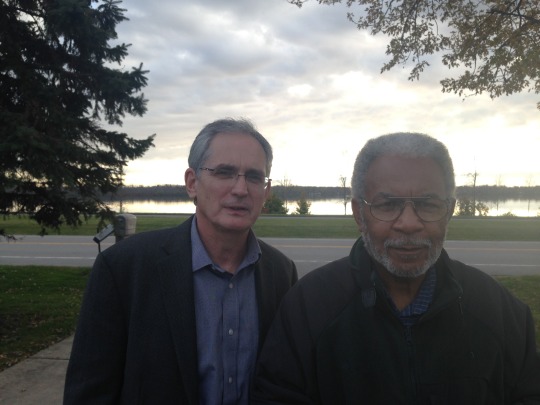
Author M.J. O’Brien and Meredith Anding outside of the Anding’s home along the Niagara River in Grand Island, New York. Just like Anding, the seemingly quiet river disguises a powerful undercurrent below the surface. About 10 miles downriver, the placid Niagara River becomes Niagara Falls.
M. J. O’Brien is the author of the award-winning “We Shall Not Be Moved: The Jackson Woolworth’s Sit-In and the Movement It Inspired.” He is currently at work on a book-length narrative study of the Tougaloo Nine and their legacy.
#Meredith Anding#Tougaloo Nine#Tougaloo College#Meredith C Anding Jr#A.M.E. Logan#Medgar Evers#Breach of Peace#West Jackson Youth Council#NAACP#Mississippi NAACP#Beverly Hogan#Bennie G. Thompson Academic and Civil Rights Research Center#Jim Hill High School#Tougaloo Alumni
0 notes
Text
Books, Books, Books
Lists are all the rage at the end of any year and this plague year is no exception. Since I’ve read a fair number of books by friends this past year or so, I thought I’d send out my “Goodreads” reviews of all three books that I’ve enjoyed with the hope of giving each a bit more recognition (and perhaps a bump in sales) in the New Year. The reviews are presented in the order that I reviewed them. All three books are available on Amazon or through your local independent bookstore. Also try IndieBound, the online independent bookseller.
[End of Year Note: My apologies for not being more active on social media lately. I’m working on my own follow up to “We Shall Not Be Moved” and have tried to stay away from all forms of distraction, including social media. With any luck, my next project, the story of the Tougaloo Nine Library Sit-In, will be on its way to the publisher at the end of 2021.]
And now, for our 2020 BOOKS, BOOKS, BOOKS!
Wave On: A Surfing Story by Michael E.C. Gery
(Amazon Digital Services, 2018, 432 pages, Autobiographical Fiction)
[Reviewed August 2019]
"A wonderfully adept stoner’s diary for the boomer generation."

I was thoroughly enchanted with “Wave On” from beginning to end. Even when I wasn’t sure exactly where we were going, the ride was exhilarating. Perhaps it was because I knew many of the places where the action takes place: Williamsburg, the Outer Banks, Annapolis, Ocean City, College Park, and even The Who concert back in 1971 [or was it ’70?] at Merriweather Post Pavilion, which I also happened to attend!! I read very little fiction but a fair amount of biography and memoir, and I must say that I rarely find a work of fiction that is as engaging and heart-driven as “Wave On.”
Part One is a pure, lovely, romantic love story that is contemporaneous with our early adulthood and, thus, easy for me to put myself in the shoes of Cro as he tries to navigate the strictures of young adulthood in a laissez-faire new world of the mid-1960s. The fact that he has been schooled at an Episcopalian Boys school and loves all of those old hymns and prayers makes it all the more real for me, having attended a 4-year Catholic high school seminary. Cro’s goofiness, uncertainty, and (initial) shyness around women also resonated.
What I loved about Part One is that Gery establishes a voice for Cro, the Narrator, that is immediate, engaging, alive, and consistent throughout the entire novelization of what I believe is Gery’s young adult life. (A new term I just picked up--“autofiction” i.e., autobiographical fiction--seems to apply here.) Cro is so normal in his struggles to understand how the world works, so honest in his mistakes, so in love with his environment—the ocean, the waves, the shore—that he makes us love them, too, perhaps a bit more than we already do. But it is that voice that intrigued me throughout. No matter what kind of scrape Cro and his interesting band of friends and lovers gets into, there is a confidence that they are up to the challenge. [I must admit that Cro’s drift during Part Two with regard to his professional aspirations and even his family life was a bit baffling, but I came to think that the weed had a lot to do with his lack of ambition and direction.]
Part Two, of course, gets a bit more complicated as real life intervenes and our little Love Couple begins to encounter troubles from within and without. I hated to see that and was certain that Cro was going to lose his wonderful Ella and Adam and couldn’t see my way through to how it all might resolve, particularly when Maryanne enters the picture and the Neil Young Concert kiss betrays a problematic (if not fatal) flaw in our hero. But I suffered through all of that, wanting to see how it all came out in the end. Although there was no deus ex machina, the surprising turn of events that helps resolve these dramatic arcs is shocking yet consistent. It all made narrative sense and helped explain why we were taken on so many to such a happy ending.
“Wave On” is a wonderfully adept stoner’s diary for our boomer generation. I can’t wait for Gery’s next work of autofiction to continue the journey with him.
Hard Road South by Scott Gates
(Blue Ink Press, 2020, 254 pages, Fiction)
[Reviewed, May 2020]
“A little jewel box of a novel.”

“Hard Road South” is a little jewel box of a novel set during the early days of Reconstruction Virginia. This beautifully rendered tale imagines a naïve Connecticut Yankee—a former Union soldier—who travels South to visit and potentially settle in some of the lush foothills of the Shenandoah Valley where he once engaged the Confederate “enemy”. Hoping to find peace while helping to reform a culture that wishes to be left alone, our hero, one Solomon Dykes, finds fast friends but also fast enemies amidst the verdant pastures of his would-be Old Virginny Home.
An early scene sets the tone: A down on her luck woman is stopped in the town of Middleburg—the place that would become the enclave of the likes of millionaires John and Jackie Kennedy and Jack Kemp Cooke a century later—by some Union soldiers still on the scene occupying this “foreign” land to ensure compliance with Union directives. Her transgression? Wearing the Confederate uniform jacket of her dead husband. The three Confederate buttons on the jacket must be removed or she will be arrested and charged with treason. Such is the over-reach of conquering heroes.
Our damsel in distress is aided by the swift thinking of one Jeb Mosby, a local farmer, who pulls out his knife and gently removes the buttons so as to spare his life-long neighbor the embarrassment of arrest.
“Such was life now,” Mosby observes. “Filled with reminders—small as they may seem—that life would not soon be returning to how he’d left it before the war.”
It is small observations such as this that gives this book its charm and its weight. Representations of what life must have been like for the conquered South are constant reminders that the likes of Solomon Dykes were not at all welcome and most likely would be rebuffed should the opportunity arise.
Scott Gates is new to novel writing, but you wouldn’t know it from his sharp eye for detail and his pacing. Gates gives his story and his characters plenty of room to breathe and develop while providing the reader with glimpses of the specifics of their war-torn lives. A Southerner by birth, Gates offers a sensibility of one trying to bridge the great divide while not shying away from the difficulties building that bridge might require.
This is a tale for our time, as well, as our nation is once again fraught with deep divisions perhaps not seen since the ending of that great Civil War more than 150 years ago. We are stuck and unable to move forward until some fundamental rift gets settled.
“Hard Road South” is a highly readable, thoroughly enjoyable yet cautionary tale for our time. Perhaps we can learn from the past and this time get things right. Perhaps …
Small Business Big Heart: How One Family Redefined the Bottom Line by Paul Wesslund
(Highway 61 Communications, 2020, 242 pages, Nonfiction)
[Reviewed, August 2020]
“Big-hearted Book Teaches That Care for Others = Good Business”

In the midst of a global health crisis—the worst we’ve seen in generations—and while we struggle as a country, as a people, to find our footing morally and culturally during a reductio ad absurdum political creep show, Small Business BIG HEART lands as a corrective, a balm to soothe frayed nerves and intemperate minds. That is not to say that this big-hearted book is pablum. No, the stories it brings are all too real—people who often have lost their way through drugs, alcohol, and bad choices; refugees who have fled horrific circumstances and are looking only to start a new life but can’t due to the stigma of being different; and one family in particular that is faced with its own dissolution as well as the loss of its dream of a thriving family business. The high-stakes rollercoaster ride that journalist Paul Wesslund takes us on is dizzying not only for its incredible highs and sometimes tragic lows, but also because it introduces a concept too often forgotten … no, disregarded … in modern business life—what corporate governance experts would call “the duty of CARE.”
Sal and Cindy Rubino are two hard-working business owners who, through the course of their trials and tribulations, manage to hold on to the dream of a creating their own business from scratch while also enduring the inevitable personal strains that such a dream exacts. The two met and fell in love while working toward Hospitality Management business degrees in Miami, but the real story starts when they try and apply the lessons of their training in the difficult day-to-day drudgery of actually running their own restaurant—simply named “The Café”—in an offbeat, run-down section of Louisville, Cindy’s hometown. It is here that their skills and wills are tested to the limits and each will have to adjust their visions to fit the realities not explored in textbooks. And it is here that their hearts will be broken, and then opened to the truths that adaptability and innovation can be applied not only to recipes and business models, but to the very people you employ and the methods you use to build a team for success.
Along the way, we meet all manner of broken individuals. The restaurant business is notorious for laying waste to lives due to its thankless dawn-to-dusk hours and the constant requirement to please the customer at all costs. Wesslund has an expert’s eye for the telling detail and the wrenching story line. [I found myself tearing up at any number of stories throughout this engaging, nonfiction tale.] His twenty years as editor-in-chief of Kentucky Living, the largest circulation monthly magazine within the state, shows in the well-drawn portraits of individuals from as far away as Bhutan and as near as Pricilla’s Place, a half-way house just a few blocks from the Café, where Cindy and Sal would find some of their best employees. Perhaps Wesslund’s (not to mention the Rubinos’) refusal to judge people by the standards of upwardly mobile middle-class values but instead, with extraordinary discernment, to look deeper into their souls to spot their special sparks and unique talents is the hallmark of this extraordinary book.
It is rare outside of evangelical circles to find a book that so openly espouses Christian principles, but Sal and Cindy make no bones about the fact that their faith community helped to save their marriage as well as their business, and Wesslund recounts the strength of those relationships and the power of religious inspiration with rare delicacy. Yet the book is not all seriousness and drama. We get, of all things, recipes (!) at the start of nearly every chapter—a creative way of introducing a new topic or the next development of this constantly churning story. And we are introduced to Cindy’s creative cooking style, to Sal’s winning smile and to their gracious, open approach to hospitality.
Small Business BIG HEART runs the gamut of the small business life cycle. It is a soup-to-nuts (literally) primer on the ups and downs of small business management. As such, it is tough medicine for anyone daring to think of creating their own start-up. Given that, however, it provides a deeply affecting microcosm of how we as a society—as a culture—might live if we, indeed, saw everyone we encountered as a member of our own family. It does not skimp on the tough decisions that must be made to keep a business afloat—the “tension between compassion and the bottom line”—but it provides a template on how to “run a business with heart”—where everyone can be a winner.
Wishing you a New Year full of new books, new ideas, new opportunities, new promise.
#Michael Gery#Wave On: A Surfing Story#Scott Gates#Hard Road South#Paul Wesslund#Small Business Big Heart#Top Books of 2020
0 notes
Text
The Trayvon Martin Generation Comes of Age
WHAT IS NOW KNOWN in certain circles as “the heroic civil rights movement” got its jump start, many would say, with the horrific torture and murder of a 14-year old boy named Emmett Till in 1955. Till’s assassination made headlines around the world and slowly, oh so slowly, things began to change. There was 42-year-old Rosa Parks’ dramatic decision not to move from the seat in the Whites-only section of the bus just three-and-a-half months after the slaying, citing Till as her point of reference for her refusal. There were the nine Black students determined to enter the all-White Little Rock High School in 1957, thanks largely to their adult coordinator and leader, the 42-year-old Daisy Bates. This was another headline-grabbing moment that alerted Americans of all stripes that all was not well in the Southland and that Freedom was a-stirring within the hearts of its Black populace.
But it wasn’t until North Carolina’s 1960 Greensboro sit-in and the wave of protests that followed in literally hundreds of cities throughout the U.S. in the ensuing months and years—coordinated and executed primarily by young college and high school students throughout the South—that things really took off. It was then that America began to listen to the voices of nonviolent protest and started to understand the depth of the racial divide that separated the country. The timing of these seemingly spontaneous acts of civil disobedience should have surprised exactly no one. They were, in large part, the direct result of the Emmett Till murder and the failure of the American jurisprudence system to prosecute that heinous crime and bring Till’s murderers to justice.
Perhaps it was Anne Moody in her powerful memoir Coming of Age in Mississippi, who first gave voice to the obvious radicalization that took place of many Black children in the mid-1950s. In vivid prose, Moody details how she first heard of Till’s murder while on her way home from high school, and what a shock it was that someone her very age could be killed for something so seemingly innocent as flirting with a White woman. After days of hearing more about the murder from both her own family and from the White family she did housekeeping work for, she recalled feeling something that would animate her future activism:
Before Emmett Till’s murder, I had known the fear of hunger, hell, and the Devil. But now there was a new fear known to me—the fear of being killed just because I was black. This was the worst of my fears. I knew once I got food, the fear of starving to death would leave me. I also was told that if I were a good girl, I wouldn’t have to fear the Devil or hell. But I didn’t know what one had to do or not do as a Negro not to be killed. Probably just being a Negro period was enough, I thought.
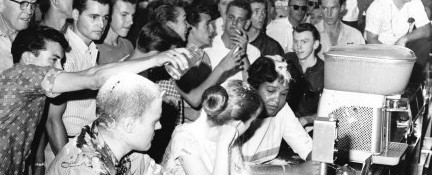
Anne Moody (right) with friend Joan Trumpauer and Tougaloo professor and mentor John Salter at the Woolworth’s counter in Jackson, Mississippi in 1963.
That simple realization, based on her knowledge that she was in the same boat as Till—and the very same age as he had been—would, less than eight years later, drive Moody into the vanguard of the civil rights movement on the streets and at the lunch counters of Jackson, Mississippi. In time, she would become a powerful spokesperson for the cause not only through her breakthrough memoir but also through her rousing public speaking to raise funds for various civil rights organizations.
MOODY’S STORY IS NOT SINGULAR. Many civil rights veterans today point to the wanton and senseless murder of young Till as their touchstone for later activism. In his award-winning “Memoir of the Movement” Walking with the Wind, longtime Georgia Congressman John Lewis recounts with similar shock and awareness what the Till killing meant for him and his generation of young Black men:
As for me, I was shaken to the core by the killing of Emmett Till. I was fifteen, black, at the edge of my own manhood just like him. He could have been me. That could have been me, beaten, tortured, dead at the bottom of a river. It had been only a year since I was so elated at the Brown decision. Now I felt like a fool. It didn’t seem like the Supreme Court mattered. It didn’t seem that the American principles of justice and equality I read about in my beat-up civics book at school mattered. . . . They didn’t matter to the men who killed Emmett Till.
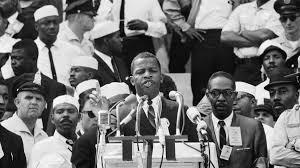
SNCC Chairman John Lewis speaking at the March on Washington in 1963.
Less than five years later, Lewis would become an essential member of the Nashville sit-in movement, an incorporating member of the Student Nonviolent Coordinating Committee—later elected its Chairman—would give an incendiary speech at the March on Washington and, in 1965, would demonstrate an enduring example of commitment to the Struggle when he was beaten bloody on the Edmund Pettus Bridge in Selma.
Historians estimate that 70,000, mostly youthful citizens participated in the sit-in movement across hundreds of cities throughout the U.S. Not only could they point to injustices done to themselves or their families, but they could point to the example of Emmett Till, which caused them to understand, as Bob Dylan so adeptly pointed out, “When you ain’t got nothin’, you got nothin’ to lose.” They were called “The Emmett Till Generation.” They put their bodies on the front lines and brought about essential change to 1960s America. It was THESE Americans who caused the enactment of the Civil Rights Act of 1964—introduced by President Kennedy just months before his death—and the Voting Rights Act of 1965.
NOW, ONCE AGAIN, AMERICA IS IN AN UPROAR. Black men continue to be killed at disproportionate rates by police and by White vigilantes nationwide. Once again, the rage has reached a critical tipping point. And the timing is directly linked to the killing of a Black youth, Trayvon Martin, eight years ago. So many young black men point to the shocking murder of Martin as the point at which they came to consciousness about America’s two-tiered system of justice. On Monday, June 1, young activist Jaden Olley, at a rally for George Floyd on the streets of Washington, DC, spoke to the PBS Newshour: “I was eight-years old when the Trayvon Martin case happened,” he said. “Ever since then, I understood that it could be me.”

My own sons, now twenty-seven and twenty-five—both young Black men—came to the same conclusion at the same time. It was in late February 2012, upon hearing of the Martin killing, that my wife and I had to have “the Talk” with these youth on the verge of manhood. One was born just three months after Trayvon Martin had been; Martin had just turned 17 when he was murdered. We had to urge them to be careful even in our own peaceful and progressive neighborhood in Northern Virginia. [Martin, as you may recall, was walking through a gated community on his way to his father’s home in the Orlando suburb of Sanford, Florida.] Our older, more sociable son admitted that ever since he was twelve, he had realized he needed to put on a smile and reassure our overwhelmingly White neighbors that he was friendly, safe, and non-threatening while walking through his own neighborhood. Imagine what a terrible burden that reality must be to carry day-to-day.
You can be assured that other young people, both Black and White, were traumatized by the Trayvon Martin killing. Not only did they see someone their own age murdered, but they later saw the murderer get off without any serious consequences for his tracking and terrorizing a Black youth. It was a shocking moment for them – just as the exoneration of the Emmett Till killers had been for an earlier generation. And then they watched as the murders continued: of Michael Brown (18), of Eric Garner (43), of Philando Castile (32), of Sandra Bland (28), of young Tamir Rice (12), of Laquan McDonald (17), of Freddie Gray (25), of Natasha McKenna (37), of Walter Scott (50). And not a damned thing happened. Many of those watchful youth determined at some point along that trajectory that if they ever had a chance to do anything about such matters, they would take charge and insist that the police keep ALL Americans safe.
That moment has now come.
AFTER WATCHING THE HORRIFFIC VIDEO of George Floyd’s murder at the hands of the Minneapolis police, thousands of young people have turned out in cities across America to express their outrage that these unconscionable criminal acts--by those who pledged to protect and defend us--have not yet been eliminated. This is the Trayvon Martin Generation coming of age and rising up to express their rage and to say that “this will not continue on my watch.”
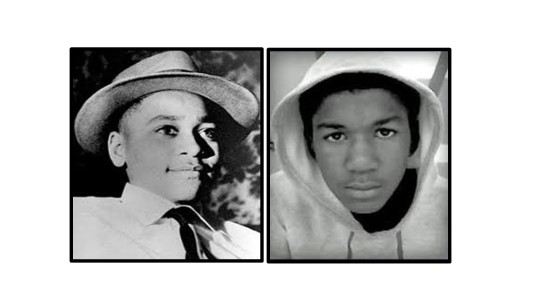
One hugely encouraging development since the early 1960s is the overwhelming number of Whites—young, old, and in-between—who are standing with their Black brothers and sisters in the streets. This is vastly different from the few Whites who committed to the struggle in the early 1960s. Joan Trumpauer, who sat with Anne Moody at thet Woolworth’s counter in Jackson, and her ilk were the exception—at least until the 1964 Freedom Summer brought hundreds of White college students to Mississippi. That experience would change the trajectory of their lives.
Think of how many lives are being transformed today on the streets of America’s cities—standing up for racial justice in the face of overwhelming odds. Indeed, thousands of Whites are publicly expressing outrage that such brutality against Blacks continues. Some are even putting themselves between their Black friends and activists and the police, using their White privilege to good effect.
But the pushback has been equally ratcheted up due to an erratic, power grabbing, unstable national leader and the craven politicians and bureaucrats who do his bidding. No matter. All of the ridiculous posturing and unlawful acts by this illegitimate President—John Lewis was the first person to publicly use this moniker—will not quell the fire that has been lit by the Trayvon Martin Generation’s coming of age. Nothing short of federal legislation reining in police forces nationwide and requiring equal protection to all of America’s citizens will quench this rage. Just like their heroic forebears in the Struggle, this generation has its Eyes on the Prize. And They Shall Overcome.
#Trayvon Martin#Emmett Till#Anne Moody#John Lewis#George Floyd#Michael Brown#Eric Garner#Philando Castile#Sandra Bland#Tamir Rice#Laquan McDonald#Freddie Gray#Natasha McKenna#Walter Scott#The Trayvon Martin Generation#The Emmett Till Generation#Joan Trumpauer#John Salter
4 notes
·
View notes
Text
Soupkitchen
It was my friend from college days, Robert Hoderny, who invited me down to the Zacchaeus Soup Kitchen when we both ended up in the mid-to-late 1970s in the Washington, DC area. Robert, already a Vietnam Veteran, joined the seminary at about the time I was planning to exit, but we kept in touch. He quickly grew disenchanted with the Church bureaucracy and left for more progressive pastures and ended up in DC with the Community for Creative Non-Violence (CCNV). When I returned from my sojourn to the Midwest, mostly a 2-year stint in Midland, Michigan (recently in the news due to a horrendous dam collapse and horrible flooding in the downtown area), I found Robert staying at some Augustinian guest house near Catholic University, participating in CCNV planning meetings, teaching religion and a new course in nonviolence, poverty and ethics at Carroll High School, and serving up soup at the soup kitchen. He invited me down one weekend and I became a somewhat irregular volunteer for the next five years.

When I was asked to write a short feature article in my American University journalism class, again taught by my beloved Professor Tinkelman (honestly, he was NOT the only professor on staff there!), my mind turned to my experiences at the soup kitchen and figured it might make an interesting piece. I was right. Not only did Tinkelman love it—he read it aloud to the entire class to my utter public embarrassment and private delight—but he also suggested I try and publish it. Ten months later, this, my first published piece, would appear on the cover of The Washington Tribune, DC’s-then most popular local weekly newspaper. (Today, The City Paper, is its successor.)
As a bonus feature to my five-part series on Dorothy Day, here is that piece, as originally written, in its entirety….
* * * * * * * * * * * * * * * * * * * * * * * * * * * * * * * * * * * * * * * * * * *
Michael J. O’Brien Soupkitchen 7/21/82
He sits as if transfixed, half dazed, staring down at the bowl of steaming soup on the table in front of him. He is black, unshaven, with the smell of cheap wine on his breath. His clothes don’t fit. They are dirty and torn. He carries his belongings in the plastic trash bag that is always at his side. He looks tired, no, exhausted, by the constant worry that life on the streets can bring. He is not alone.
He is one of the hundreds that daily filter through the Zacchaeus Community Kitchen. Some are young. Some are old. Most are black. All are poor. Many, like this man, claim the streets for their home. They come to the kitchen for some daily nourishment: a bowl of soup, a slice of bread, and some shelter from the storm of street life.
Zacchaeus Kitchen, located inconspicuously in the 600 block of L Street, NW, has been the breakfast table for thousands of Washington, DC’s poor for almost 10 years. Started by a group of caring activists who call themselves the Community for Creative Non-Violence (CCNV), the kitchen remains one of the few places in the city where a person can, with no hassle, with no questions asked, get a decent meal for free.

Mother Theresa, the saint of Calcutta, served the kitchen’s first bowl of soup in October of 1972. CCNV founder Ed Guinan remembers the occasion this way:
“Zacchaeus Kitchen was our first real poverty program. When we decided to go with it, we rented a small place on New York Avenue. Mother Theresa happened to be in Washington at the time, so we invited her over to help launch the thing. I made the soup and she ladled it out to the twelve or fifteen people who came by that day.”
Guinan expected to serve only 40 to 50 walk-ins per day. But in a few months, after word got out, more than 150 of the city’s poor and homeless were coming to the kitchen for their daily meal. The New York Avenue space proved inadequate for the crowd, so the Community found another space—its present L Street location—to set up kitchen headquarters. Now, Guinan says, more than 300 come to the kitchen every single day.
The Community takes responsibility for seeing that there is enough food as well as enough people to cook and serve each day. They accept no government subsidy.
Much of the food is donated. Over the past 10 years, CCNV has established a network of generous Church groups and wholesale food outlets that supply canned goods and surplus produce. Ottenberg’s bakery has given its surplus bread to the kitchen since the program began.
Volunteer workers come from all over: church groups, Catholic high school students, committed teachers, government workers, and other who somehow heard about the kitchen’s work and decided to get involved. CCNV members fill in during the work week when volunteers are scarce.
The kitchen also gets help from the District’s court system. Offenders with minor violations are sentenced from 10 to 300 hours of service at the kitchen, depending on the nature of their misdemeanor. “We couldn’t do it without them,” one volunteer said. “Sometimes they’re the ones who keep this place going.”
A typical day at the kitchen beings when workers start to trickle in at about 6:30 a.m. Usually, someone has already put the water on to boil the night before, so the first step is to add the beans to the steaming cauldrons, since beans take a long time to cook. Workers then slice onions, potatoes, carrots, celery, tomatoes, and whatever else can be found to make the soup interesting and palatable.

Former priest and then-poverty pioneer Ed Guinan (with wife Kathleen) at the first iteration of Zacchaeus Community Kitchen in Washington, DC, in the 1970s.
Rarely is there any meat for the soup, but when there is, it usually must be picked from the bones of hams, turkeys, or chickens that have already been served to more privileged groups at restaurants and posh dinner parties throughout the city. This is the leftover kitchen: the place that serves food that nobody really wants to people whom almost everyone would prefer to forget.
Anarchy reigns once the workers get geared up. One person is designated chief cook, but others give their advice—asked for or not.
“The soup looks kind of thin to me. What do you think?
“Maybe we can put in some noodles to thicken it up.”
“How about some of this seasoning stuff?”
“It needs more onions, lots of onions!”
Similar deliberations continue until about 9:15 a.m. when, ready or not, the doors open to the hungry masses awaiting their first, perhaps their only, meal of the day.
The ragged crowd shuffles through the downstairs cooking area, up the steps to the serving room. The room can comfortably accommodate 50 to 60 people. It is always crowded. On nice days the tables and benches are set outside on the sidewalk, adding a café flair to an otherwise dank and dismal atmosphere.
The serving room is usually serene enough before the onslaught. Trays of bread sit neatly on each table along with pitchers of hot tea (in the winter) or Kool-Aid (in the summer). Once the crowd enters, however, the place turns into a bombshell of congestion and confusion.
The hungry are asked to take a seat while volunteers serve them. One worker hurriedly ladles out the soup into oversized bowls as others rush to bring each bowl, along with an empty cup and spoon, to the tables. The process of serving each person individually takes a long time and often the demands of the crowd can overwhelm the small band of workers.
“Can I have a bowl of soup over here?”
“Where’s my cup?”
“Got any sandwiches today?”
“Why can’t you get some heat in here?”
“Can I take a loaf of bread home with me?”
“How about a cigarette, man?”
This kind of chaos continues for about two hours. The noise is terrible. The smell is worse. Tempers run short. Fights break out often. Somehow everyone gets fed.
By 11:30 a.m., after three huge pots of soup and countless loaves of bread have been devoured, after hundreds of people have found their way in and out of the kitchen doors, the place begins to quiet down. Workers wash the dishes and mop the floors. When the last few stragglers have been ushered out, the windows are shut, one final inspection is made, then the doors are closed and locked. The poor have been given their daily bread for another day.
On the wall by the stove where the soup is prepared, a newspaper clipping is taped. It contains the words of a man who did similar work with the poor more than 100 years ago. His assessment of the job of feeding the hungry seems strikingly valid for those who help out at Zacchaeus Kitchen. He told his workers”
“You will find out that charity is a heavy burden to carry, heavier than the bowl of soup and the full basket . . . . You are the servants of the poor, always smiling and always good humored. They are your masters, terribly sensitive and exacting masters, you will soon see. The uglier and dirtier they will be, the more unjust and insulting, the more love you must give them. It is only for your love alone that the poor will forgive you the bread you give to them.”
--St. Vincent de Paul
#Zacchaeus Soup Kitchen#Ed Guinan#Vincent de Paul#Community for Creative Non-Violence#CCNV#robert hoderny#Joe Tinkelman#American University School of Communications#AUSOC#Kathleen Guinan#Soupkitchen
0 notes
Text
Dorothy Day - “Dissenting Voice of the American Century”
During this month of memorialization of the 50th anniversary of the Kent State atrocity—where students protesting American military aggression in Vietnam were gunned down on their own campus—it is well to remember that The Catholic Worker staged the first public protest against the Vietnam War way back in the summer of 1963 while this misguided attempt at containing Communism’s spread was in its early stages. Read all about this and more of The Catholic Worker’s incredible legacy of protest and resistance in Part V, the last of my series on Dorothy Day and her pioneering newspaper. [Links to the previous four posts in this series can be found at the end of this article.]
* * * * * * * * * * * * * * * * * * * * * * * * * * * * * * * * * * * * * * * * * * * * *
Vietnam
The Catholic Worker began featuring the radical pacifist writings of Cistercian monk Thomas Merton, as well as those of brothers and Catholic priests Daniel and Philip Berrigan as early as 1959. Others affiliated with The Worker organized the Catholic Peace Fellowship, an organization aimed at educating Catholics on the Church’s neglected tradition of pacifism. When news of the Vietnam War broke, The Catholic Worker was ready.
The first demonstration ever held to protest the war was held by The Catholic Worker in the summer of 1963. It was tiny, but after a ten-day period, The War Resisters League brought two hundred and fifty people to join the Workers. Together they made national television and launched the protest movement against the war.
When Congress passed a law in 1965 forbidding the burning of draft cards, The Catholic Worker called for public draft card burning. David Miller, a Worker volunteer, burned his card and caused an international sensation. Another Worker, Tom Cornell, had gained some notoriety as early as 1960 by burning his draft card at a demonstration against the launching of the Polaris submarine. Later, five other Workers, including Cornell, burned their cards at a rally in Union Square.
Dorothy Day heartily supported the protests and spoke at the rally:
… I speak today as one who is old, and must endorse the courage of the young who themselves are willing to give up their freedom. I speak as one who is old, and whose whole lifetime has seen the cruelty and hysteria of war in the last half century. . . .
I wish … to point out that we too are breaking the law, committing civil disobedience, in trying to encourage all those who are conscripted to inform their consciences, and to heed the still, small voice, and to refuse to participate in the immorality of war.
Counter demonstrators across the street shouted at her, “Moscow Mary! Moscow Mary!” Others yelled, “Give us Joy! Bomb Hanoi!” and “Burn yourselves, not your draft cards.”
Roger Laporte, a Catholic Worker volunteer present at the rally, heard the cries of the counter-demonstrators and, perhaps as a witness to others that he was willing to do anything to stop the war, took their demands seriously. A few days after the rally, at five in the morning, LaPorte bought a can of gasoline; walked to the Secretariat Building of the United Nations; sat down on the landing of the Isaiah Stairway under the words carved into the walls: “They shall beat their swords into ploughshares, neither shall they study war anymore”; poured the gasoline over himself and struck a flame. He died the next day. The incident made international news.

Isaiah Stairway at the United Nations Plaza in New York City.
The very night of Laporte’s self immolation, almost as if Heaven wished to mark the sacrifice of this youth and the thousands more that were to die in Vietnam, all the lights went out from New York City to Montreal. It was the night of the Great Blackout of 1965.
The Catholic Worker came under heavy criticism by the Catholic press for this action by one of its members. Although no one suspected LaPorte would consider such an extreme measure, Dorothy Day felt some responsibility for the tragedy. She never criticized LaPorte’s act, but she was badly shaken by it and called for strenuous prayer and fasting. She prayed that Roger LaPorte’s sacrifice would be accepted by God and that no one would follow his example.
The Catholic Worker continued its support of the Peace Movement. It called for massive resistance to the draft and for men to refuse payment of taxes that went to support the war effort. The Berrigans wrote lengthy articles for the paper detailing accounts of their acts of civil disobedience against the war.
When Cardinal Spellman went to Vietnam for his Christmas visit and called for victory in the war, Dorothy Day decried his statement in the article, “In Peace is My Bitterness Most Bitter.” She paraphrased Christ’s words, writing “Our worst enemies are those of our own household,” and said, “What words are those he (Spellman) spoke against even the Pope, calling for victory, total victory? Words are as strong and powerful as bombs, as napalm.”
Viva La Huelga!
The Catholic Worker also took up the cause of Cesar Chavez and exposed the plight of the migrant farm worker. Chavez was trying to organize the vast migrant worker population into a union and, thus, force growers into paying better wages and providing better treatment to the migrants. The Catholic Worker brought national attention to Chavez’s cause. The paper carried accounts of Chavez’s activities in the fields of Delano, California, and of the increasing harassment by the growers. The paper called for a boycott of non-union grapes and lettuce and for the picketing of any supermarkets that did not carry union-approved products. [Some of my fellow seminarians and I would make trips to local Baltimore supermarkets on Saturday mornings in the early 1970s to test their produce and urge grocers and their customers not to buy scab, non-union grapes and lettuce.]
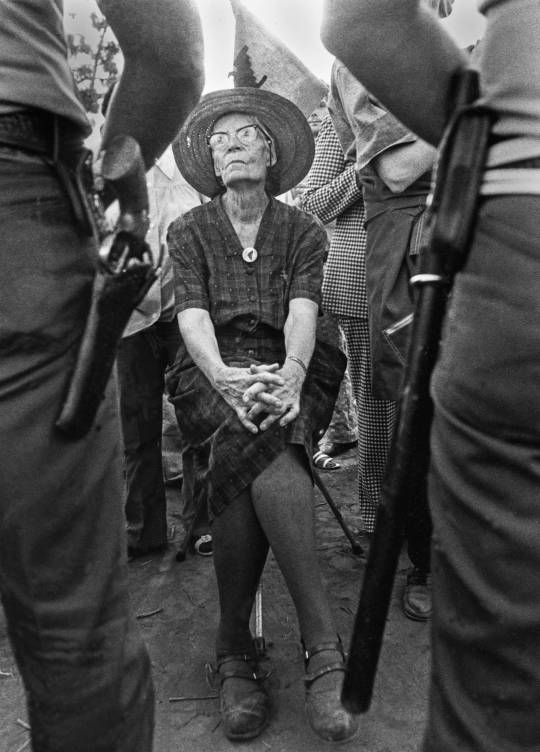
Dorothy Day’s final arrest was in collaboration with fellow Catholic Cesar Chavez and the United Farm Workers in 1973.
The Seventies
The Catholic Worker carried its opposition to the Vietnam War into the 1970s. It continued to call for war tax resistance and draft resistance. Letters or articles by the Berrigan brothers, written from their jail cells, were prominently featured.
In the summer of 1971, Dorothy Day made another pilgrimage, this time to Russia. As in Cuba, she recounted her experiences with the Russian people and reported on the country’s economic conditions, as well as on how the Church was surviving alongside its godless counterpart, the State.
In 1973, at the height of the United Farm Workers’ strike, Day went to Fresno to participate in a non-violent demonstration aimed at bringing attention to the illegal jailing of union members who picketed the growers’ fields. She went to jail with nearly one hundred other demonstrators. She was 76 years old.
The Catholic Worker accepted articles from friends around the globe who sought to bring attention to injustice in their own locales. Stories on Northern Ireland terrorism, on Philippine repression, on strip mining in West Virginia, on resistance in Brazil, on tragedies in Bangladesh, and on the Attica Prison uprising all appeared in the paper, along with instructions in nonviolent resistance and pieces on cooperative land-holding and voluntary poverty. The Worker’s outcries against the U.S. nuclear weapons arsenal continued, as many Workers went to jail because of their symbolic, attention-getting protests against the nuclear arms buildup.
Dorothy Day’s Death – The Work Continues
Dorothy Day died in November of 1980, at the age of 83. Her last years were spent in semi-retirement. She did not travel much after 1976, when her health began to fail, but she continued each month to write her journal “On Pilgrimage” for the paper. [I discovered through reading her columns that Day was, indeed, at Maryhouse three years ago when we visited. She was confined to her room, but her spirit permeated the halls of the place.]
While retired, Day continued to do what she could for the poor and dispossessed of this world. Three hours before her death, she was on the phone begging for aid for the victims of a devastating earthquake in Southern Italy.
The paper and the movement continue. Two Workers, Marj Humphrey and Peggy Sherer, edit the paper. Other Workers manage the two New York City Houses of Hospitality (Maryhouse and St. Joseph House); they feed hundreds each day, and give shelter and clothing to those who have none. The paper still relies on appeals in the Spring and Fall for the means to continue the work. Marj says that it costs more than $10,000 each month to print and distribution the paper, and that circulation figures are back up to a healthy 95,000 (mostly as a result of the Anti-War Movement of the sixties and seventies).
The paper still sells for a penny a copy (twenty-five cents for a year’s subscription) and is intent on carrying on the work that Peter and Dorothy began almost fifty years ago. Recently incidents in El Salvador, Guatemala, Chile, the Philippines, and Korea have been highlighted—each article written by someone with first-hand experience and knowledge of the horrors committed in these terror-torn countries. One need not be a Catholic to submit an article or to work for the paper—only subscribe to the basic tenants of the Catholic Worker philosophy.
Of course, there is always room in the paper for one of Peter’s “Easy Essays” or for one of Dorothy’s old articles, along with pieces about farming (The Worker still maintains a farm in Marlboro, New York), about activities at the Houses, and about the problems of being poor in New York City.
Concerning the future of the work, Marj Humphrey says, “It’s all in God’s hands. We will continue as long as He allows it.”
* * * * * * * * * * * * * * * * * * * * * * * * * * * * * * * * * * * * * * * * * * * * * *
In the final lines of her 1952 autobiography The Long Loneliness, Dorothy Day remembered how it all started:
We were just sitting there talking when Peter Maurin came in.
We were just sitting there talking when lines of people began to form, saying “We need bread.” We could not say “Go, be thou filled.” If there were six small loaves and a few fishes, we had to divide them. There was always bread.
We were just sitting there talking and people moved in on us. Let those who can take it, take it. Some moved out and that made room for more. And somehow the walls expanded.
We were just sitting there talking and someone said, “Let’s all go live on a farm.”
It was as casual as all that, I often think. It just came about. It just happened. . . .
The most significant thing about The Catholic Worker is poverty, some say.
The most significant thing is community, others say. We are not alone any more.
But the final word is love. At times it has been, in the words of Father Zossima, a harsh and dreadful thing, and our very faith in love has been tried through fire. . .
It all happened while we sat there talking, and it is still going on.
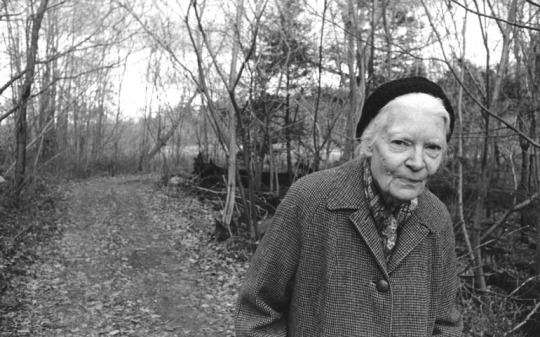
“It is still going on,” and it is a comforting thought that the work will continue as long as God allows it. With any luck, He’ll allow it to go on forever, or at least until the need no longer exists.
* * * * * * * * * * * * * * * * * * * * * * * * * * * * * * * * * * * * * * * * * * * * * *
This ends my series on Dorothy Day and the Catholic Worker Movement and newspaper. Here are the links to the other posts from this series:
Part I: https://blog.notbemoved.com/post/615785179039039488/dorothy-day-and-her-hope-filled-revolution-of-the
Part II: https://blog.notbemoved.com/post/616481057106264064/the-catholic-worker-always-found-room-for-one
Part III: https://blog.notbemoved.com/post/616931763626868736/dorothy-day-and-her-catholic-workers-didnt-skimp
Part IV: https://blog.notbemoved.com/post/617658737377820672/civil-disobedience-and-the
For more information about Dorothy Day and her legacy, check out the new biography by John Loughrery and Blythe Randolph [Dorothy Day: Dissenting Voice of the American Century] and the new documentary by Martin Doblmeier [Revolution of the Heart: The Dorothy Day Story]
#Dorothy Day#Peter Maurin#Daniel Berrigan#Philip Berrigan#Berrigan Brothers#Thomas Merton#Vietnam#Vietnam War#Caesar Chavez#Farmworkers Union#Roger Laporte#David Miller#Tom Cornell#draft card burning#Viva la Huelga!#The Long Loneliness#Marj Humphrey#Peggy Sheerer
0 notes
Text
Civil Disobedience and the Legacy of The Catholic Worker
After publishing last Part III of this series last week, a friend and colleague commented how unfortunate it is that the conservative Supreme Court justices (all of whom profess to be Catholic or were raised Catholic) do not seem to share this passion for social justice that Dorothy Day embodied. I agree and find it confounding. The Catholic Church took a hard-right turn in the 1980s and continues on that path today, despite Pope Francis’s best efforts. In any event, it is well to remember that there is (or was) a place in the Church for dissenters, for activists, and for those with a passion for the poor and afflicted—even if they don’t make it to the highest echelons of ecclesiastical or political life.
Dorothy Day never seemed much interested in climbing any ladders or achieving a certain status within the Church she served. “Don’t call me a saint,” she would say. “I don’t want to be dismissed that easily.”
Here’s Part IV of my series on Dorothy Day and the history of The Catholic Worker newspaper.
*********************************************************************************
The Post-War Period
After Peter’s death, Dorothy Day continued to publish the paper, to run the New York House of Hospitality, and to oversee the growing Catholic Worker Movement. By the start of 1950, the paper’s circulation had increased slightly to 60,000; circulation remained at this plateau throughout the fifties.
The paper was still an eight-page tabloid and it looked the same as it had for more than 15 years. Only woodcuts were used for artwork; photographs were too expensive to print. In the thirties and forties, the paper featured woodcuts of Catholic worker-saints—St. Peter the fisherman; St. Paul writing in prison; St. Joseph the Worker, and many others—all the handiwork of Worker Ade Bethune.

Woodcuts by Ade Bethune ...
In the fifties, another artist, Fritz Eichenberg, produced some stunning works of art for the paper. Eichenberg, a Quaker, portrayed most sensitively in his woodcuts and engravings the spirit of The Catholic Worker. His “Christ on the Breadline,” “The Labor Cross,” and “Last Supper,” captured visually what The Worker’s writers were trying to express in words. Day wanted to touch those poorest of the poor who could not read so she often printed full, front-page reproductions of Eichenberg’s work.

... and Fritz Eichenberg graced the pages of nearly every issue of The Catholic Worker.
The Catholic Worker continued to be built around Dorothy Day’s writing. She changed the name of her column to “On Pilgrimage,” a title that seemed to describe the nature of her life.
Others contributed articles regularly. Michael Harrington, a resident Worker who later became an economist, consistently provided pieces for the paper. Harrington’s most famous work, The Other America, written in 1961, is said to have sparked the Kennedy/Johnson War on Poverty. Ammon Hennacy, a pacifist anarchist, wrote extensively of his “one-man revolution.” Robert Ludlow, an intellectual and lover of Gandhi’s principles of nonviolence—he wrote a striking piece on Gandhi’s death—became an associate editor of the paper. Columns about the day-to-day activities of the House of Hospitality and about life on the farm provided engaging copy each month.
More Issues
The Catholic Worker continued to fight for justice and peace. When the underpaid gravediggers of Calvary Cemetery—Catholics and members of a CIO union—went on strike against New York’s Cardinal Spellman, Dorothy Day supported the gravediggers. The Cardinal thought the strike was inspired by Communists and refused to negotiate. He even used seminarians, of all people, to break the strike and forced the striker to dissolve the CIO affiliation and join an American Federation of Labor union instead. Day criticized the Cardinal’s tactics and the “shameful seminarians” who broke the strike.
At the onset of the Nuclear Age, The Catholic Worker denounced the continued testing of the A-bomb and the development of the H-bomb, and called for total disarmament of nuclear weapons. Indeed, The Worker even criticized the Catholic press for its “unbalanced” portrayal of Russia and its people.
The paper also opposed the anti-Communist Smith and McCarran Acts:
Although we disagree with our Marxist brothers on the question of the means to use and to achieve social justice, rejecting atheism and materialism in Marist thought and in bourgeois thought, we respect their freedom as a minority group in this country…. We protest the imprisonment of our Communist brothers and extend to them our sympathy and admiration for having followed their conscience even in persecution.
The paper continued to criticize the Capitalist system. “Communism, considered as an economic system apart from its philosophy, is not so much the antithesis, the opposite and the contradiction of Christianity as Capitalism is.” Such critiques did not win the paper many friends in the highly charged “Red-Scare” atmosphere of Joe McCarthy America. One priest wrote to ask The Catholic Worker, “Why don’t you come out in the open, declare yourselves Bolshevik Communists and fight the Church like men?” Day, a woman, stood firm, even quoting the Popes and their attacks on economic materialism and Capitalism.
Civil Disobedience
In 1955, seven Catholic Workers, including Dorothy Day and Ammon Hennacy, staged a protest with twenty-three others from the War Resisters League against New York City’s annual air-raid drill. The Civil Defense Act required that all take shelter for at least 10 minutes.
The Workers considered the drills scare tactics and war preparations; they would have no part in them. The protesters informed the police beforehand of their intention to violate the law. When the siren sounded, instead of heading for shelter, the protesters sat on benches in City Hall Park. They were arrested and detained for nine hours before being released on fifteen hundred dollars bail.
When their case came to trial, the protesters made a statement explaining their brazen stance. They said they did not wish to participate in an action aimed only at creating a war mentality. Taking cover from an atomic attack was ridiculous, they said, and they offered their action, and any punishment for it, as a small act of penance for dropping the atomic bomb on Japan. The judge found them guilty but suspended their sentence, so they served no jail time.

For the next four years, Workers along with others continued their protests. They were jailed each time for anywhere from five to thirty days. The Catholic Worker carried accounts of the demonstrations and explained Workers’ rationale for participating. Workers wrote about their own jail experiences and, thus, brought public attention to jail conditions and to the lives of those so confined. In 1960, one thousand people showed up to protest the “war games,” as The Worker dubbed them. When arrests were made, the Workers were passed over, prompting Hennacy to ask one of the arresting officers if he wasn’t shirking his duty. After 1960, the City gave up on its annual air-raid drills.
Slum Landlord
In 1956, Dorothy Day was handed a summons ordering her to appear before a City judge to answer charges of being a slum landlord and of running a firetrap. Since the thirties, The Catholic Worker had run a House of Hospitality, with rooms and beds for those who had no home of their own. The Houses were always liveable, although no one ever worried about conforming to any housing regulations. When Day appeared in court, she explained to the judge that The Catholic Worker was a charitable organization and that the apartments were for those who had no other place to live. “All the more reason for you to provide suitable housing” for them, the judge growled. He fined her $250 and told her that she and her fifty “tenants” would have to vacate in 10 days. Day was stunned.
Someone contacted The New York Times, which picked up the story. Public outcry about the incident caused the judge to apologize to Day, suspend the fine, and give her enough time to raise the $28,000 needed to make the house conform with local building codes. Because of the publicity, within a month most of the funds had been donated and soon the House was refurbished to meet City standards. But “Holy Mother City” had the last word. In 1958, the City informed Day and the Workers that they would have to move to make room for a new subway line!
About Cuba
When Fidel Castro’s revolution in Cuba succeeded in 1959, The Catholic Worker came out on Castro’s side. The paper’s critics were outraged. How could a Catholic paper endorse a government opposed to the Church? Even friends of The Worker were astonished and thought the paper had compromised its pacifist position. Day answered both critics and friends in the article “About Cuba.”
To her critics, Day said:
It is hard … to say that the place of The Catholic Worker is with the poor, and that being there, we are often finding ourselves on the side of the persecutors of the Church. . . . One could weep with the tragedy of denying Christ in the poor. . . . Fidel Castro says he is not persecuting Christ, but Churchmen who have betrayed him (in the poor). . . . (Castro) has said that the Church has endured under the Roman empire, under a feudal system, under monarchies, empires, republics and democracies. Why cannot she exist under a socialist state? He has asked the priests to remain to be with their people….
To her friends, she said:
We are certainly not Marxist socialists nor do we believe in violent revolution. Yet we do believe that it is better to fight, as Castro did with his handful of men … than do nothing. We are on the side of the revolution. We believe there must be new concepts of property, which is proper to man … there is Christian communism and a Christian capitalism as Peter Maurin pointed out. We believe in farming communes and cooperatives and will be happy to see how they work out in Cuba.

The criticisms continued, however, and Day, at age 65, decided to go to Cuba to report first-hand on Castro’s revolution. Her reports were printed in her “On Pilgrimage” column from September through December of 1962. She recounted day-to-day experiences among the Cuban people in a touching way that gave her readers an idea of exactly what was happening to both Church and State in Cuba. Many praised her Cuban reports as her best journalistic work. One admirer wrote simply, “Thank you for your courage on Cuba.” After Day’s personal reports on Cuba, the controversy stopped.
(To Be Continued)
This is Part IV of a series of articles on The Catholic Worker. Click on links for Part I, Part II and Part III.
#Dorothy Day#The Catholic Worker#Ade Bethune#Fritz Eichenberger#civil disobedience#Michael Harrington#The Other America#A Penny A Copy#Robert Ludlow
0 notes
Text
Dorothy Day and her Catholic Workers Didn’t Skimp on the Works of Mercy or the Beatitudes
When Pope Francis I appeared before a Joint Session of the U.S. Congress in September 2015 he mentioned four notable Americans who exemplify the American spirit. Among them—and the only woman—was Dorothy Day. [Abe Lincoln, MLK, and Thomas Merton also got the nod.] Of Day, he said:
In these times when social concerns are so important, I cannot fail to mention the Servant of God Dorothy Day, who founded the Catholic Worker Movement. Her social activism, her passion for justice and for the cause of the oppressed, were inspired by the Gospel, her faith, and the example of the saints.
It was thrilling to hear someone so noteworthy praise Dorothy Day in the same breath as these other “worthies” of American life. Until recently—with a new book and documentary about her—it was rare for the name of Dorothy Day to be mentioned at all.

Pope Francis approaching the podium to address a Joint Session of Congress in September 2015
I know this from my own experience. Since the publication of my book about the civil rights movement in 2013, I’ve had the opportunity to address many an audience and have generally provided the sponsors a summary of my “bio” which always mentions Dorothy Day (along with Dr. King and Mohandas Gandhi) as one of my inspirations. While the other two are well known, Dorothy Day’s name usually prompts blank stares or shoulder shrugs. It seems, though, that perhaps now Day’s time has come. Just as her great mission was taken up during the Great Depression, her “comeback” is happening during the Great Pandemic. There is such need and suffering among our own people today, it is good to have a Dorothy Day to look to for inspiration and hope that if we all pull together, we may just get out of this ditch.
On that point, here is what Pope Francis, during that same speech to Congress, said about politics and its true intent.
Each son or daughter of a given country has a mission, a personal and social responsibility. Your own responsibility as members of Congress is to enable this country, by your legislative activity, to grow as a nation. You are the face of its people, their representatives. You are called to defend and preserve the dignity of your fellow citizens in the tireless and demanding pursuit of the common good, for this is the chief aim of all politics. A political society endures when it seeks, as a vocation, to satisfy common needs by stimulating the growth of all its members, especially those in situations of greater vulnerability or risk. Legislative activity is always based on care for the people. To this you have been invited, called and convened by those who elected you.
Called to seek the “common good”—not just politicians, I might add, but all of us. May we all pull together, work together, as we seek to overcome what undoubtedly is one of the greatest challenges of our lifetimes.
And now, Part III of my series on Dorothy Day and the Catholic Worker.
[Click here for Part I and Part II]
* * * * * * * * * * * * * * * * * * * * * * * * * * * * * * * * * * * * * * *
Issues
Initially, The Catholic Worker was viewed as Catholicism’s answer to Communism. Commonweal’s first analysis of The Catholic Worker phenomenon was entitled: “A Catholic Paper vs. Communism.” The Catholic Worker, it said, was a journal established “to offset the polemics of Communism with a clear exposition of the principles of social justice enunciated in papal encyclicals; and to oppose Communism and atheism by fighting for social justice for the working man.”
Indeed, Dorothy Day reveled in the comparison. She used to enjoy recounting the story of how Catholic Workers competed with Communists when selling newspapers on the street corner. When the Communist shouted, “Read The Daily Worker!” a Catholic Worker would retort, “Read The Catholic Worker daily!!”
Under the headline “Specimens of Communist Propaganda,” The Catholic Worker would even debunk some of the more outlandish attacks on the Catholic Church by the Communist press. Its battle against Communism gave The Catholic Worker some degree of respectability in Catholic circles. But when the paper began to strike out at the established bourgeois practices of American Catholicism itself, its reviewers turned sour.
One such attack was directed at the concurrence of Catholic institutions, schools, and hospitals in their policies of racial segregation, as practiced by American society as a whole at the time. “We Have Sinned Exceedingly” was the title of one editorial on the subject.
Another issue on which The Catholic Worker and the Church hierarchy were on opposite sides was the Child Labor Amendment. The Catholic Worker favored the Amendment, which sought to end industry’s use and abuse of children in the workforce. The Church feared that any legislation concerning the lives of children might eventually lead to government interference in the parochial school system.
Because of these and other contentious issues, many Catholics raised questions about how “Catholic” The Catholic Worker really was. The Diocese of New York’s Chancery Office received letters urging the Church to take some action against The Catholic Worker. The head of the Diocesan Office of Censor of Books wrote a letter to Day and later visited the CW offices. His only “action” was to ask that The Catholic Worker find a priest to act as an editorial advisor for the paper to “avoid criticism and … be of assistance to the future development of the work.”
Day gladly accepted this suggestion and asked Father Joseph McSorley, the same priest who had told her not to ask the Church’s permission to publish, to serve as the paper’s advisor. Although she often differed with the hierarchy, Day always tried to obey their wishes. She once said, “If the Cardinal ordered me to stop publishing tomorrow, I would.” Of course, he never did.
Labor
Throughout the thirties, The Catholic Worker kept its focus fixed on the poor and on labor issues. Although Peter Maurin was not interested in furthering Labor’s materialistic gains—“Strikes don’t strike me,” he would say—Day supported organized labor and often picketed with strikers.
During these years, she reported on the Borden Milk Company’s dispute with its deliverymen and asked readers to boycott Borden products. She covered the organization of the Southern Tenant Farmers Union and the New York Seamen’s walkout. The Catholic Worker even provided food and shelter for the striking sailors.

April 1936 edition of The Catholic Worker
Day even interviewed John Lewis, the first president of the Congress of Industrial Organizations; she was in favor of worker unionization. She went to Detroit to help her readers understand the sit-down strike by the United Auto Workers, a CIO affiliate, and to Pittsburg and Johnstown where the CIO was trying to organize the workers of the Bethlehem Steel Corporation.
Toward the end of the 1930s, after Labor had made some major strides, and with the increasing possibility of war in Europe, The Catholic Worker shifted its emphasis to another crucial issue—Peace.
Blessed are the Peacemakers
As early as October of 1933, The Catholic Worker made clear that it was a pacifist paper. It announced it would send delegates to the “United States Congress Against War” to represent “Catholic Pacifism.” Three years later, the Worker started an organization of Catholic conscientious objectors. Workers saw what was brewing in Europe and were determined to be ready “when the next war comes along.” The Catholic Worker’s pacifism was based on spiritual principles:
As long as men trust to the use of force—only a superior, more savage and brutal force will overcome the enemy. We use his own weapons, and we make sure our own force is more savage than his . . . . Today the whole world has turned to the use of force . . . . If we do not emphasize the law of love, we betray our vocation.
The following years of the paper’s history showed just how much love American Catholics had for pacifism. The Spanish Civil War began in 1936, pitting Communist against Catholic. American Catholics revered Generalissimo Francisco Franco and considered his revolution against Communism to be a “holy war.” The Worker refused to take sides and blamed both Communists and Catholics alike for the outbreak of hostilities.
“Catholics who look to Spain to think Fascism is a good thing because Spanish Fascists are fighting for the Church against Communist persecution,” the Worker observed, “should take another look at recent events in Germany to see just how much love the Catholic Church can expect.”
Although many European Catholics agreed with The Catholic Worker’s sentiments, Americans were appalled by its position. Many accused the paper’s editors of being “Communists masquerading as Catholics”—a criticism that would often be leveled against The Catholic Worker in the years to come.
The paper maintained its pacifist stance throughout World War II. It called for massive draft resistance and strikes by those who worked in the war-supporting industries. Pacifist priests wrote articles on the Catholic tradition of conscientious objection. The Worker even ran an alternative service camp in New Hampshire for Catholic conscientious objectors.
The newspaper suffered dramatic losses as a result of its principled stand. In November 1939, the paper’s circulation had grown to about 130,000 monthly. During the next six years, subscriptions steadily declined, especially subscriptions by bishops who had accepted bundled shipments of the paper for sale in their churches. By the end of the war, the paper was reaching only an estimated 50,000 subscribers.

Dorothy Day, Peace Activist
In the face of all manner of criticism, Dorothy Day held out:
We are still pacifists. Our manifesto is the Sermon on the Mount, which means that we will try to be peacemakers. Speaking for many of our conscientious objectors, we will not participate in armed warfare or in making munitions, or by buying government bonds to prosecute the war, or in urging others to these efforts.
The Catholic Worker was, of course, a “voice crying in the wilderness.” Men did not drop their weapoins or refuse to make munitions. The war continued to its horrifying conclusion—Hiroshima. In a column entitled “We Go On Record—” Day wrote bitterly of this historic tragedy:
Mr. Truman was jubilant. President Truman. True man; what a strange name, come to think of it. We refer to Jesus Christ as true God and true man. Truman is a true man of his time in that he was jubilant. He was not a son of God, brother of Christ, brother of the Japanese, jubilating as he did. He went from table to table on the cruiser, which was bringing him home from the Big Three conference, telling the great news; “jubilant” the newspapers said. Jubilate Deo. We have killed 318,000 Japanese.
That is, we hope we have killed them, the Associated Press, on page one, column one of the Herald Tribune, says. The effect is hoped for, not known. It is to be hoped they are vaporized, our Japanese brothers, scattered, men women and babies, to the four winds, over the seven seas. Perhaps we will breathe their dust into our nostrils, feel them in the fog of New York on our faces, feel them in the rain on the hills of Easton.
Day and her Workers sent a telegram to the President: “We beg you in the name of Christ crucified to do all in your power to cause this abomination of desolation, this new discovery to be buried forever. Far better to be destroyed ourselves than to destroy others with such fiendish and inhuman ingenuity.”
Pleas for nuclear disarmament occupied many of The Catholic Worker’s pages in future years, but not before it dealt with a more personal tragedy—the death of Peter Maurin.
Maurin’s Legacy
In April of 1944, Peter had a stroke that left him “unable to think,” as he put it. Although he remained with The Worker, his role in its operation decreased dramatically. His health, too, continued to fail until he was completely bed ridden, except for Sunday Mass, which he faithfully continued to attend. After much suffering, he died in March of 1949.
Maurin had spent the last 15 years of his life building a dream. And what a reality it had become! As a result of The Catholic Worker, Maurin’s ideas had spread all across the country, as well as to Europe and Australia. Houses of Hospitality “for the immediate relief of those in need” opened in many major American cities. In Boston, St. Louis, and Washington, D.C.; in Cleveland, Los Angeles, and Chicago; in Detroit, Milwaukee, Buffalo, and Philadelphia houses were opened by enthusiasts who tried—each in his or her own way—to practice Peter’s “gentle personalism.”

Many also started farming communes to prove that people could find work, food, and shelter on the land. The New York house bought a farm in 1935. It has maintained one ever since, first on Staten Island, then later at Easton, Pennsylvania, and Newburg, New York. Others, too, tried their hands at farming, though often unsuccessfully because of their lack of experience. Those who did succeed wrote glowingly of their experiences for the paper.
Maurin influenced an entire generation of American Catholics; his “green revolution,” as he called it, challenged the youth to delve more deeply into social questions and to experience the joys of Lady Poverty and of Christian Love for the least of Christ’s brethren.
(To Be Continued)
#Pope Francis#Dorothy Day#Peter Maurin#Blessed Are The Peacemakers#The Catholic Worker#Harry Truman#Atomic Bomb#Thomas Merton#MLK#Gandhi
0 notes
Text
The Catholic Worker Always Found ‘Room for One More’
Last week’s “Part I” of my series on Dorothy Day and The Catholic Worker brought some wonderful responses, including one from an unexpected source. Lauretta (Sotak) Jenkins messaged me to let me know that she once was part of a Catholic Worker-type organization called The Young Christian Students—a group out of Chicago that fostered youth involvement in social justice issues in the 1940s, ‘50s, and ‘60s. It was through YCS that in the early 1960s Lauretta would meet a number of SNCC (Student Nonviolent Coordinating Committee) activists and later marry one of them, Timothy Jenkins—then an important SNCC presence in Mississippi and vice-president of the National Student Association. [I met Tim and Lauretta through my involvement with the non-profit social justice organization Teaching for Change.]
This week, Lauretta and I spoke and she directed me to a brilliant article by Professor Paul T. Murray, emeritus professor of sociology at Sienna College in Loudonville, New York. His article, “‘We belong in the wider world’: The Young Christian Students and the Civil Rights Movement”, appeared in the Winter 2017 edition of U.S. Catholic Historian, which, at Murray’s suggestion, was dedicated to Catholic involvement in racial justice issues. It’s a VERY small world. Dr. Murray was the first academic to give my book We Shall Not Be Moved a five-star review on Amazon in 2013.
Now, here’s Part II of my American University School of Communications writing assignment on The Catholic Worker newspaper:
Part II of “The Catholic Worker: The Voice of American Catholic Radicalism
Humble Beginnings
The paper sold for a penny a copy; there was no advertising. After Union Square, Day mailed the paper out to editors of Catholic papers and periodicals all over the country and to prominent American Catholics. She explained the paper’s predicament this way:
It is not as yet known whether it will be a monthly, a fortnightly or a weekly. It all depends on the funds collected for the printing and distribution. Those who can subscribe, and those who can donate, are asked to do so.
This first number of The Catholic Worker was planned, written and edited in the kitchen of a tenement on Fifteenth Street, on subway platforms, on the “L,” [and on] the ferry. There is no editorial office, no overhead in the way of telephone or electricity, no salaries paid.
The money for the printing of the first issue was raised by begging small contributions from friends. A colored priest in Newark sent us ten dollars and the prayers of his congregation. A colored sister in New Jersey, garbed in holy poverty, sent us a dollar. Another kindly and generous friend sent twenty-five. The rest of it the editors squeezed out of their own earnings, and at that they were using money necessary to pay the milk bills, gas bills, electric light bills.
By accepting delay the utilities did not know that they were furthering the cause of social justice. They were for the time being, unwitting cooperators.
Next month someone may donate us an office. Who knows?

A sample Catholic Worker newspaper from the early days
Success!
After a few weeks, encouraging letters and contributions began to filter in; a second issue was assured. The editors settled into a monthly routine for publishing the paper and volunteers trickled in to help with the work of writing, producing, and distributing it. They found more space for offices and were somehow able to keep most of the bills paid.
Each issue of the paper brought new stories of Depression hardships, labor concerns, and the Church’s attitude on social justice issues. Articles were often written in a personal style that related both the facts and the author’s impressions of the event or issue under scrutiny. Day started her own column, “Day by Day,” in which she gave her own spiritually sharp analysis of current events. Letters from clergy and readers were printed, as were reviews of current books on economic, social, and spiritual subjects. Peter Maurin’s “Easy Essays” continued to be featured. Withing six months, the paper’s circulation had jumped from 2,500 to 25,000. By May 1, 1935, the paper’s second birthday, 110,000 copies of The Catholic Worker were being printed and distributed monthly. The paper was an overwhelming success!
Maurin’s Vision
The philosophy of the paper—and the movement that was quickly beginning to sprout—is a difficult one to encapsulize. Peter Maurin explained The Catholic Worker’s stance in one of his “Easy Essays:”
What the Catholic Worker Believes
The Catholic Worker believes
In the gentle personalism
Of traditional Catholicism.
The Catholic Worker believes
In the personal obligation
of looking after
the needs of our brother.
The Catholic Worker believes
In the daily practice
of the Works of Mercy.
The Catholic Worker believes
In Houses of Hospitality
For the immediate relief
Of those who are in need.
The Catholic Worker believes
In the establishment
of Farming Communities
where each one works
according to his ability
and gets
according to his need.
The Catholic Worker believes
In creating a new society
within the shell of the old.
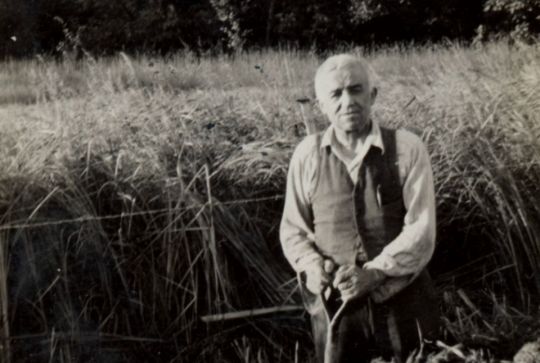
Peter Marin, the inspirational co-creator of the Catholic Worker Movement, pictured here on a CW farm in 1941
“Creating a new society within the shell of the old,” a phrase borrowed from the Communist-led International Workers of the World (the IWW—or the Wobblies, as they were known), was the kernel of Maurin’s vision. He called himself a Christian Communist, and he stood in opposition to the two operative economic systems of the day—dictatorial Marxism and finance Capitalism. Doroth Day shared Maurin’s vision. She defined Christian Communism as “worker ownership of the means of production and distribution, as distinguished from nationalization.”
Both Maurin and Day envisioned a society of decentralized cooperatives where a distinct employer class would be eliminated, and where widespread ownership of property by all men would be a stepping stone to a Communism in accord with Christian teachings. One might also label their position as Christian anarchism. It meant radical decentralization of government and industry.
The Catholic Worker was opposed to the bourgeois mentality of Capitalism that left out the poor and those not equipped for “survival” in the get-what-you-can world of American economic Darwinism.
The Worker believed that each person in need was an “ambassador of God.” They treated the poor as if each was another Christ, in accordance with Christ’s own words: “What you do to the least of my brothers, you do to Me.”
Hospitality
The daily practice of the Works of Mercy—feeding the hungry, sheltering the homeless, clothing the naked, instructing the ignorant—became the backbone of The Catholic Worker Movement. Workers practiced voluntary poverty, giving all they had to the poor and serving in every way they could the forgotten and rejected of this world.
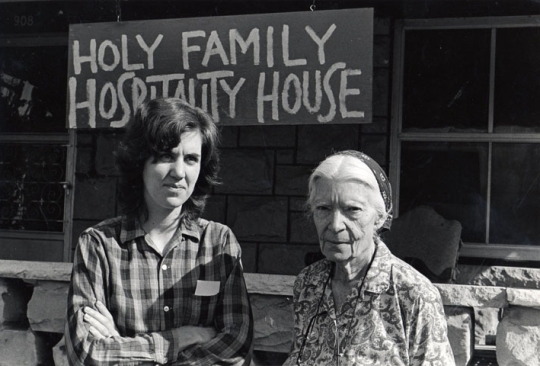
Not long after the first issues of the paper were on the streets, people began to come to the Catholic Worker offices for food and clothing. The poor—and there were many during the Depression years—believed that The Catholic Worker editors were sincere; they came to share in the hospitality about which they had read. At first, only a few came. Whatever the need, the Workers tried to provide it from their own belongings. If a person needed a coat, Workers would search their own closet for an extra one. If someone was hungry or cold, he was invited in to the offices for a cup of coffee and a sandwich. Word spread of The Catholic Worker’s generosity. Soon hundreds, then thousands were coming daily for food and clothing. The Worker’s only recourse was to beg their readers for help.
The first appeal for clothing in October of 1933 read:
Shoes Needed
One of our friends brought in some men’s shirts and two pairs of shoes, all of which were immediately given to other friends who were in need. We ask any of our readers who have winter coats or men’s or women’s shoes to send them in to the office. Men’s shoes are more necessary than anything else.
Almost every month that followed, especially during the Depression years, the paper carried more appeals for clothing and for money to carry on the work of feeding the poor and publishing the paper. Eventually, enough food, money, and clothing came in that an appeal was necessary only twice a year—once in the Fall and once in the Spring.
Ask and You Shall Receive
For almost fifty years The Catholic Worker has existed on appeals. Its business policy has always been to rely on God for whatever expenses they incur. The saints come in handy, too, when bills begin to mount up. The Workers’ food bills alone have gone as high as $6,000. Whenever a money crisis looms, Workers hound heaven for a solution. Invariably a reader will call with a large donation or enough small contributions will trickle in to meet the need.
The Catholic Worker has never carried advertising, nor has it ever accepted subsidies from either Church or State. They beg for every penny they get. Day explained it this way:
No one asked us to do this work. The mayor of the city did not come along and ask us to run a bread line or a hospice to supplement the municipal lodging house. Nor did the Bishop or Cardinal ask that we help out the Catholic Charities in their endeavor to help the poor. No one asked us to start an agency or an institution of any kind. On our responsibility, because we are our brother’s keeper, because of a sense of personal responsibility, we began to try to see Christ in each one that came to us. If a man was hungry, there was always something in the icebox. If he needed a bed—and we were crowded—there was always a quarter around to buy a bed on the Bowery. If he needed clothes, there were our friends to be appealed to, after we had taken the extra coat out of the closet first, of course. It might be someone else’s coat, but that was alright too.
Any subsidy, Catholic Workers believe, would hinder their editorial freedom. And free they need to be to take the radical stands they have taken—and continue to take.
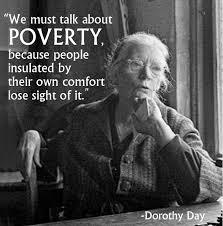
(To Be Continued)
Part I of this series can be found at: https://blog.notbemoved.com/post/615785179039039488/dorothy-day-and-her-hope-filled-revolution-of-the
#Dorothy Day#The Catholic Worker#Peter Maurin#Lauretta Jenkins#Timothy Jenkins#SNCC#Young Christian Students#YCS
0 notes
Text
Dorothy Day and her Hope-filled “Revolution of the Heart”
What a time we’re in! I’ve put my blog on hold while working on my next book, but feel the need to come back with a few pieces to “Keep Hope Alive” in these dark times. And just in time for a Dorothy Day revival! Dorothy Day, the enterprising journalist and social activist (and perhaps soon to be saint of the Catholic Church) is having something of a revival of her reputation. A new biography (Dorothy Day by John Loughery and Blythe Randolph) and a new documentary (“Revolution of the Heart: The Dorothy Day Story” by Martin Doblmeier) have put Day back in the limelight where she belongs. She’s recently appeared in the New York Times Book Review (written by prominent religion historian Karen Armstrong, no less), for an extensive New Yorker profile, and even today in the REVIEW section of the Wall Street Journal! Day’s renaissance couldn’t come at a better time, when, thanks to the pandemic, the fragility of our safety net for the poor shows itself for what it really is: benign neglect, if not downright abuse.
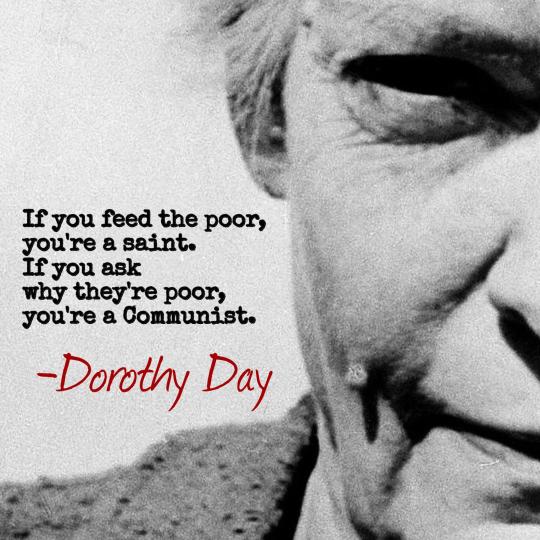
I’ve been an admirer of Dorothy Day’s for decades, dating back to my time as a Catholic seminarian in Baltimore in the 1970s when we were encouraged to think a lot about the poor and about social conditions and how best to put our social consciences to work to improve things. After leaving the seminary and trying to find my way throughout the rest of the ‘70s, I enrolled in The American University’s School of Communications and set about trying to improve my skills as a writer. While pursuing a second bachelor’s degree in Communications (the first, from St. Mary’s Seminary College, was in Philosophy), I happened upon a wonderful journalist/teacher Joe Tinkelman, who taught some of my earliest writing classes and whose consistent encouragement caused me to believe I might have a career as a writer someday.
For his “American Newspapers” class, Tinkelman pushed us to write a long-form journalistic piece profiling a newspaper of our choice. My mind immediately went to The Catholic Worker, Dorothy Day’s creation from the 1930s that was still going strong in the 1980s. I thought a 50-year retrospective was in order, so I set about to research this little-known gem and report back to Tinkelman and the class. The research I did (mostly at Catholic University) put me in deeper touch with Dorothy Day, her philosophy, her writing, and her work with the poor of New York City.
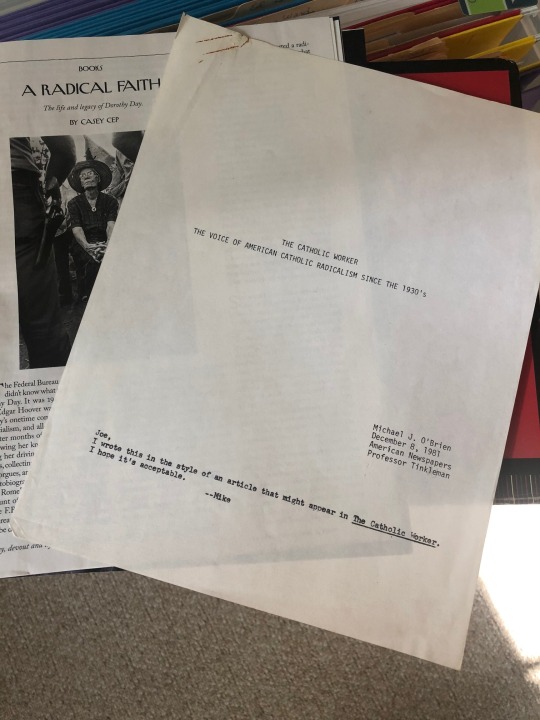
For the next four weeks, I’m posting a serialized version of the paper I did for Professor Tinkelman as a tribute to his inspiring teaching and to Dorothy Day herself and her incredible work. Read with caution: You may just get radicalized!
* * * * * * * * * * * * * * * * * * * * * * ** * * * * * * * * * * * * * * * * * * * * * * * * * *
The Catholic Worker—The Voice of American Catholic Radicalism Since the 1930’s (Part I)
By Michael J. O’Brien, 12/8/81 – American Newspapers, American University, Professor Joe Tinkelman
On a piercingly cold night in December of 1978, I stepped from the sub-compact I had so comfortably been traveling in with a former seminarian classmate of mine onto the curb of Second Avenue on the Lower East Side of Manhattan. We were on our way to Maryhouse, the Catholic Worker’s House of Hospitality for homeless women, to attend one of the C.W.’s Friday night meetings. It was my first visit to the Catholic Worker Headquarters. Before I could even close the car door, a middle-aged Black man with the smell of whiskey on his breath and of urine on his clothes—the smell of the destitute in any city—asked me for some money “for a cup of coffee.” I remember looking into this man’s half-dazed eyes, seeing behind him the lights of Second Avenue—the bars and novelty shops, the cafes and movie houses that give the street a feeling of one continuous cabaret—and wondering how to tell him on this of all nights that I could not give him a penny. [Part of our seminary training was to decline to give money to alcoholics. “They’ll only use if to further their illness,” we were told.]
I was already late for the C.W. meeting, so instead of inviting him for a bite to eat at one of those cafes, I asked him to join me at Maryhouse. I knew he would at least be warm there and perhaps could even get a cup of hot coffee. He refused, and as my friend and I dashed across the street to get to the meeting, I heard him cursing us. I can’t think, now, of a more appropriate greeting for my first visit to the Catholic Worker—a group that has served the poor and the dispossessed of the Bowery for almost 50 years.
At the time, however, I was only thinking of our lateness! As we opened the doors to Maryhouse and rushed up the stairs of this seemingly ancient tenement, I was awed by the thought that Dorothy Day, co-founder of the Catholic Worker—“both a newspaper and a movement”—graced these steps daily. For all I knew, she was there that very night, this being her primary residence in the City. I didn’t know much about Dorothy Day then, but I knew she had chosen to live her life among the poor and to serve them as if they were Christ. That was enough to spark my interest in her and in her work.
My friend and I entered the doors of the auditorium to a standing-room only crowd. More than two hundred people were packed into this tiny hall that serves as a distribution center for the newspaper and the meeting hall for “the clarification of thought,” as Peter Maurin, the Catholic Worker’s other founder, put it.
We took our places among those standing in the back and I caught a glimpse of Daniel Berrigan, the radical Jesuit pacifist, who was speaking to the throng. Berrigan was scheduled to talk that night—I guess that’s why so many people showed up—on the poetry of Thomas Merton, a well-known Catholic monk and author who died in the late 1960s. Berrigan read to us some of Merton’s poems concerning war, peace, death, and nuclear armaments. After each poem, he gave us his own interpretation of what he believed Merton was trying to convey; they had been good friends.

Thomas Merton, Dorothy Day, and Daniel Berrigan: Three pillars of radical Catholic thought in the 1960s.
The entire evening had an aura of unreality about it for me. Here I was in Dorothy Day’s house listening to Daniel Berrigan speaking on Thomas Merton—three pillars of radical Catholic thought represented under one roof! The history of modern Catholic radicalism came alive for me that night. It is some of that history, particularly the Catholic Worker’s singular role in its development, that I will attempt to relate in the text that follows.
The Young Radical Journalist
One could say Dorothy Day was a journalist from birth. Her father was a sports writer for the New York Morning Telegraph; her brothers became newspaper editors. Journalism was in her blood.
She became involved in questions of social justice at an early age. She read Upton Sinclair’s The Jungle and Jack London’s essay on class struggle while still in high school. One of her brothers worked on a Chicago paper (where the family lived during Day’s adolescence) called The Day Book, an experiment by Scripps-Howard that reported on the ups and downs of the Labor Movement. The paper’s accounts of the the struggles of the poor and of the workers stirred Dorothy deeply. She began to feel that her life was linked to theirs, that she had received “a call, a vocation, a direction” for her life.
Dorothy Day began her career as a journalist in 1916 at the age of 18 by taking a job at a newspaper coincidentally named The New York Call—a socialist daily that was heavily involved in the labor issues of the day. Later she worked on The Masses, a monthly Communist magazine. After the periodical’s suppression by the Attorney General during the post-World War II “Red Scare”, Day worked for The Liberator, the successor to The Masses.
Her assignments took her to all kinds of strike meetings, picket lines, and peace rallies. She interviewed Leon Trotsky while he was living in New York and writing for a Russian socialist newspaper. She picketed the White House and went to jail for a month with a group of suffragists. She counted as her friends Eugene O’Neill, the great American playwright; Max Eastman, editor of The Masses; and John Reed, author of Ten Days That Shook the World, a journalists’s account of the Russian Revolution. (The new movie REDS explores aspects of the lives of all three of these men.)
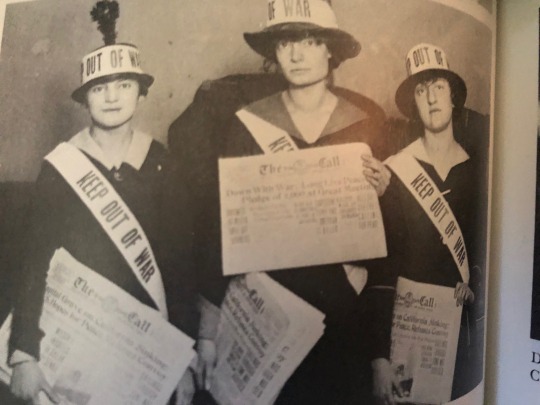
A 1917 photo of Dorothy Day (center, holding a copy of The New York Call) urging the U.S. NOT to enter WWI.
An Unlikely Convert
Although her early years as a journalist were spent advocating for causes and movements that were considered godless (Communism, after all, considers religion as an opiate), Dorothy Day converted to Catholicism in 1927 at the age of 30. She saw the Catholic Church as the church of the poor and of the worker, and she wanted to be one with them in every way. Also, she had given birth to a little girl through a common-law marriage, and the overwhelming love she experienced for both her lover and her daughter made her believe that there must be a God.
Day’s conversion caused her much suffering; she had to leave the man she loved because he would not condone her religious leanings. But she put principle before personal comfort, as she would so many times in the future.
After her Baptism, Day found she was no longer one with her comrades. They could not understand her religious convictions and she found it difficult as a Catholic to participate in demonstrations and meetings that were organized by Communists. She continued to report on the plight of the working man for Catholic periodicals—she even did a series of articles for the Catholic press explaining Marxist-Leninism!—but she felt far removed from her earlier radical involvement. She was at a loss as to how to reconcile her two great loves—her newfound love for God and her continued love for the working man and the poor.
An Answered Prayer
Dorothy Day often warned people to be careful how they prayed. “God takes you at your word,” she would say. It was through just such a prayer that she found a solution to her dilemma and that The Catholic Worker came to be.
In early December 1932, Day was covering a march on Washington, D.C., by the Communist-led Unemployment Councils. The march was an attempt by the Depression’s unemployed workers to bring their grievances to Congress. Day was reporting on the march for two Catholic periodicals, America and Commonweal. She became distressed by the march’s lack of Catholic leadership and felt she could no longer sit by and watch as others, especially Communists, took the lead in fighting for the working man. She had to find a way to get involved in the struggle as a Catholic.
On December 8, just after the worker’s march and, coincidentally a Catholic Holy Day, Dorothy Day went to the Shrine of the Immaculate Conception—still under construction in Washington—and prayed fervently that God would show her the way out of the box she was in. Remarkably, God took her at her word. When she returned home to New York, Peter Maurin, the man who was to teach her the way out, was waiting for her in her apartment.
Peter Maurin
Maurin had been sent to Day by the editor of Commonweal because they “thought alike.” He was a French peasant and was deeply rooted in Catholic social tradition. He had studied Aquinas, Augustine, and the socialy encyclicals of the Popes, as well as the many contemporary Catholic social writers, including Hillaire Belloc, Emmanuel Mounier, and the Russian activist and social theorist Peter Kropotkin.
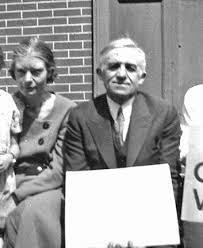
Dorothy Day and Peter Maurin sitting for a group Catholic Worker photo in the early 1940s.
Maurin had a plan for the reconstruction of the then-crumbling American society. His plan had four planks: (1) houses of hospitality for the immediate relief of those in need; (2) farming communes to relieve the wretched unemployment brought about by urban industrialization; (3) round table discussion “for the clarification of thought” on social issues; and, (4) a newspaper to get these ideas to the man and woman in the street. Maurin’s entire plan was aimed at “creating a new society within the shell of the old” where it would be “easier for men to be good.”
The Birth of a Newspaper
Dorothy Day didn’t immediately comprehend the breadth of Maurin’s thought, but she jumped at the idea of publishing her own newspaper. She found out that the Paulist Press—a Catholic publishing outlet—would print 2,500 copies of an eight-page tabloid (originally 9”X12”) for fifty-seven dollars. Day feverishly began writing articles for the fledgling paper—articles on the plight of sharecroppers, child labor, the hourly wage for factory workers, and racial injustice. These, along with Maurin’s “Easy Essays”—short, free-flowing verse for quick and easy consumption of ideas by the man in the street—made up the copy for the papers first edition.
Maurin wanted to call the paper The Catholic Radical, but because of her knowledge of Communist periodicals in the U.S., Day insisted on calling it The Catholic Worker—a direct challenge to the then-popular Communist paper The Daily Worker. “Man proposes, woman disposes,” Maurin jokingly demurred. And so, The Catholic Worker was born.
They didn’t seek permission from the Church to use the word “Catholic.” Day wondered about this, but a priest friend of hers wisely advised, “Never ask permission.”

The enduring Catholic Worker masthead
The first issue of The Catholic Worker was ready for distribution on May Day—May first, the great Communist holiday celebrating the working masses—of 1933. In a short column entitled To Our Reader, Day dedicated the paper:
For those who are sitting on park benches in the warm spring sunlight.
For those who are huddling in shelters trying to escape the rain.
For those who are walking the streets in the all but futile search for work.
For those who think that there is no hope for the future, no recognition of their plight—this little paper is addressed.
It is printed to call their attention to the fact that the Catholic Church has a social program—to let them know that there are men of God who are working not only for their spiritual, but for their material welfare.
Dorothy Day was determined to make her stand along with others involved in the workers’ struggle, so in typical in-your-face radical fashion, she along with three of her Catholic supporters went to hock the paper in Union Square, where 50,000 workers had gathered for a massive show of support for Communism. They were scoffed at and they sold few papers, but Day and her friends were satisfied with their results. The paper had been launched. In addition, Day and Maurin had embarked on the great pilgrimage that would consume the rest of their lives.
(To Be Continued)
#Dorothy Day#Peter Maurin#Daniel Berrigan#Thomas Merton#Joe Tinkelman#The Catholic Worker#American University#AU Communications#St. Mary's Seminary College#smsc
1 note
·
View note
Text
The Federation’s Expansive Vision
Eighth in a Series on the Federation of Southern Cooperatives
During the Federation’s 50th Anniversary year, marvel at its broad sweep and bold initiatives during its early days. Another installment from the Federation’s 50th Anniversary Commemorative Booklet: “50 Years of Courage, Cooperation, Commitment & Community.”
Funds for Families as well as for Co-ops
It was clear to the early cooperative boosters that the best way to help impoverished farmers was to give them access to capital to help smooth out the cyclical nature of their businesses and to grow their small operations. The credit union movement—a cooperative-like structure—offered the perfect antidote to individuals who had no credit history, could not get loans from White-owned banks, and who actually needed very little to make a go of their start-up businesses or to buy feed or seed for their family farms. “If a community is experiencing common problems with little resources,” Charles Prejean explained, “it made so much sense to pool resources and use them to satisfy a common need.”
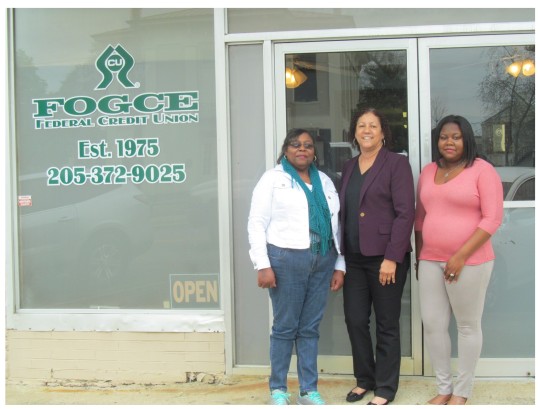
Friends of Greene County Employees Credit Union--one of the many credit unions fostered by the Federation over the years. Pictured are Carol Prejean Zippert, President (center) flanked by Joyce Pham, Manager (left) and Kierra Epps, Accounting Clerk.
Representatives from several credit unions were present at the Federation’s formation. Once the organization was up and running, creating community-based credit unions became a key focus of the staff. One of the Federation’s early hires was Earnest Johnson, a self-taught financial wiz whose entire professional career would be spent helping low-income Southern farmers create and sustain credit unions so that they could have access to capital when they needed it. “For us to build on the civil rights movement,” Johnson once said, “we had to own businesses and we had to provide decent jobs for people.” The only way to do that was by pooling resources and building equity. Johnson worked tirelessly during his more than 30 years with the Federation to help struggling credit unions for low-income rural people to avoid the pitfalls of many such start-up entities: poor lending and collection practices, careless record keeping, inexperienced board members, and untrained management and lending staffers. Johnson became the Federation’s ambassador to its member credit unions, dispensing advice and offering his expertise to the 25 or so credit unions that have been under the Federation’s umbrella over the years.
Sadly, despite Johnson’s untiring efforts, the NCUA’s stringent requirements for size and capital investment forced many of the Federation’s member credit unions during the past 20 years either to merge with larger ones (most of which were not Federation members) or to liquidate altogether. Today, only six credit unions remain as part of the Federation’s family of cooperative institutions. Cooperative economics expert Dr. Jessica Gordon Nembhard notes, “The NCUA’s lack of understanding of the importance of these grassroots financial institutions to the Black community limits the ability of the [Federation] to provide support and asset-building opportunities to its members.” The Federation continues to advocate for less onerous requirements for locally based credit unions in order to help its member cooperatives provide the kind of capital lending base that their members require to succeed.

Ernest Johnson addresses credit issues at one of the Federation’s Annual Meetings at its Training Center, Epes, Alabama. Johnson was a pioneer in bringing credit union services to the poor of the South.
Cooperative Health Care and Housing
The number of times the Federation referred to its work as a “movement”—not only in the early days, but throughout its fifty years—is instructive.
Co-ops have become a vanguard and foundation for an economic base for Black people in the rural South. The Co-op Movement has successfully conveyed the idea and ideology that poor and oppressed people can find a way to work out of their problems by working together through the Federation. 1972 Annual Report
The survival of our member co-ops, the continued existence and growth of our Federation and the entire Cooperative Movement are testimony to our resilience and belief in working together collectively to cause and create the changes that are necessary. 1974 Annual Report
As we meet to celebrate the 14thAnnual Meeting of the Federation of Southern Cooperatives, there is much for us to be thankful for to God and [to] each other in the cooperative movement. 1981 Annual Report
Building on the work of the Civil Rights Movement, the Federation has organized a community-based cooperative economic development movement among 25,000 low-income families working in over 100 communities in the rural South. 1993 Annual Report
We have completed another year of success and struggle to develop a meaningful cooperative movementto serve African-American farmers and other low-income people and communities across the Southeast. 2010 Annual Report
Those working for the low-income rural poor saw what they were doing was not just creating better jobs or better prices for their members and their products. Cooperatives were bringing an entirely new spirit to the once-depressed and demoralized citizens of the rural South, providing them a way to work together to gain a share of the American Dream. The vision was not simply economic in nature, though that was a large part of it. The vision was one of uplift, of hope, of self-determination, of working together for the common good. As evidence of this, some of the early visionaries expanded their initial scope of enhanced capital access and agricultural and handicraft cooperatives to encompass an array of democratically run institutions that could attend to all of the basic needs of the members and the community, including affordable health care and decent, well-built housing.
Not surprisingly, many of these innovations occurred in the proximity of the Federation’s home base—in the counties surrounding the Epes Training Center in Alabama. The Federation staff and their families provided the leaven for all sorts of innovative cooperative ideas for rural development and community progress. The Federation first stretched into these endeavors in the early 1970s with the advent of a housing project conceived on some of the land purchased with the PLBA. It took years of advocating for funding from the federal government and fighting with local building permitting agencies, but in 1980, the Wendy Hills Housing Project was launched (named after Wendell Paris, the first occupant of the Epes Training Center land), with 40 new homes for needy residents. Additional Federation-supported housing projects have yielded funding for more than 700 new or refurbished housing units for members primarily in Alabama.
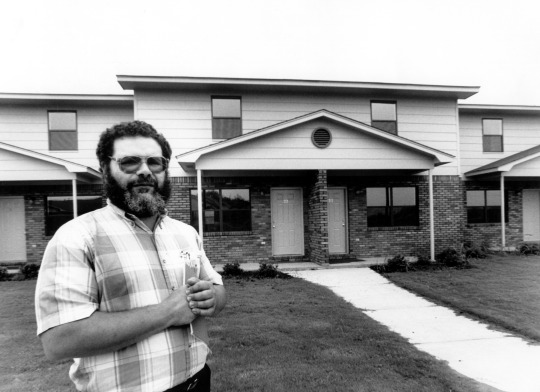
Federation staffer John Zippert stands in front of an affordable housing apartment complex, the Sanders-Black apartments in Eutaw, Alabama, built by the Federation.
It cannot be underestimated the impact that these modest homes had on the local populace, many of whom had lived for much of their lives in tenant farmer shacks with no indoor plumbing or electricity. Access to these amenities was a huge advance, both in terms of quality of life and improved health. Additionally, to the degree possible, the Federation ensured that those who built the homes were people indigenous to the area, and that those knowledgeable about construction techniques passed along that knowledge to younger trainees who participated in jobs training programs funded by federal government grants.
Health care was another matter altogether. It is a truism that rural areas typically suffer from lack of adequate medical care and that residents often have to travel to urban centers for anything more than the treatment of the common cold. From its earliest days, the Federation’s leadership had envisioned the creation of family health care centers to provide basic health and dental care to rural residents in “medical scarcity areas” within the Federation’s geographic footprint. With the opening of the Training Center at Epes, the possibility for creating a start-up health care initiative became a possibility.
By 1972, the Federation had received funds from the U.S. Department of Health, Education, and Welfare (HEW) and other agencies to plan for the creation of a health care demonstration project to be run out of the Training Center. Should the program prove effective and successful, it could serve as a model for other such centers throughout the South and, indeed, throughout the country.
Out of this start-up concept came the Black Belt Family Health Care Center. As with so many of the Federation’s initiatives, its indigenous health care program ran into local White resistance and was forced eventually to merge with the White-controlled West Alabama Health Services. A promising concept of self-help cooperative health care was aborted to serve the interests of local elites rather than those most in need of its services. The concept remains a potential game-changer for providing health care services to underserved rural communities.
0 notes
Text
Panola Land Buying Association
Here’s the story I promised months ago (contributed by veteran civil and land rights activist John Zippert) … about the Panola Land Buying Association. With many more news outlets picking up on the travesty of Black Land Loss (See last month’s story in The New Yorker, The Washington Post and next month’s Atlantic Monthly), it’s important to note the wins along the way. Here’s the eighth in my series on the Federation of Southern Cooperatives, which has been fighting for Black farmers and their land for more than 50 years.
________________________
The Panola Land Buying Association (PLBA) in Alabama arose out of the civil rights and economic and social justice struggles of the 1960’s. The members of PLBA worked as tenant farmers, raising cotton, on three large plantations in north Sumter County, Alabama, near the town of Panola.
The members of PLBA joined Rev. Fred Shuttlesworth’s Alabama Christian Movement for Human Rights and were part of its Sumter County affiliate. Shuttlesworth was a fearless civil rights preacher from Birmingham who called Dr. King to join him to fight Bull Conner in the 1963.

The Reverend Fred Shuttlesworth, whose Alabama Christian Movement for Human Rights inspired farmers in Sumter County to band together into the Panola Land Buying Association.
The tenant farmers, moved to action by the Civil Rights Movement, tried to register to vote in Sumter County. They also sued the three plantation owners for their share of the government price support payments on cotton. The tenants won their lawsuit in 1966, in part because one of the plantation owners, John Rogers, was also the chair of the Sumter County Agricultural Stabilization and Conversation Service (ASCS) Committee. The role of the local county ASCS committee was to determine crop allotments, crop yields and payments of subsidies when acreage allotments were reduced.
The ASCS regulations, promulgated by the USDA, provided that tenants and sharecroppers were to receive their proportionate share of acreage divergence payments and other government subsidies. At the local county level these rules were not implemented fairly. The tenants won a small settlement from the lawsuit, although most say the plantation owners took the money back and applied it to debts.
After the cotton was harvested in 1966, the plantation owners sent eviction notices to all 100 tenants on the three plantations, saying that they would have to move and seek a new livelihood because the owners were switching from cotton to cattle and raising pine trees on their land. Privately the plantation owners were heard to say they were tired of “uppity Negro,” although they didn’t exactly use those words. There were many other places across the South during this time where Black sharecroppers and tenants fighting for justice were evicted and had to find new places to live and work.

Cotton bales ready for market.
Some of the one-hundred families moved to Chicago, some moved to Tuskegee and forty families remained behind in Sumter County, living with relatives, looking for land to farm, houses to live in and alternative employment if farm land could not be found. These families formed the Panola Land Buying Association.
Three community organizers, affiliated with the Southern Cooperative Development Program and the Federation—Lewis Black from Greensboro, Albert Turner from Marion, and Thelma Craig from Lisman—began meeting with the PLBA member families to determine what they wanted to do. The families expressed their desire to purchase some land to farm and homes for their families to live in comfortably. They met in a small community store owned by Lewis and Tessie Thomas, in the Warsaw community that was part way between Panola and Gainesville. (Tessie Thomas, was later elected Constable in 1968, one of the first Black elected officials in Sumter County.)
Lewis Black found a white merchant, P. M. Norwood, in Gainesville who had just lost three tracts of land, totaling 1164 acres, in a foreclosure. At that time, the owner of foreclosed land had up to two years to redeem their land for the price of the foreclosure, plus legal fees and interest. Black persuaded Norwood to enter an agreement with the PLBA to redeem his land and sell two of the three tracts to PLBA.
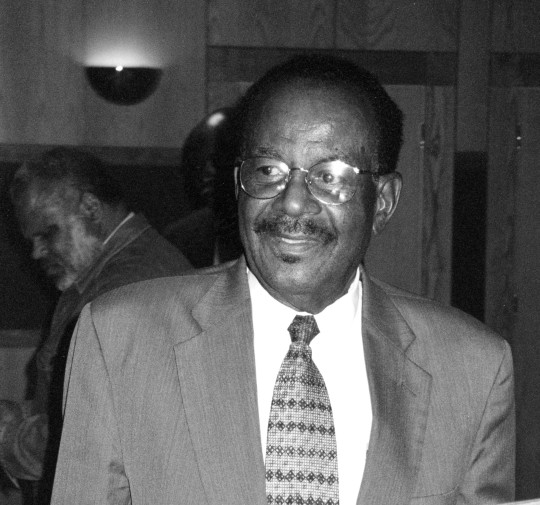
Lucius Black (pictured) and his twin brother Lewis were champions of the economic justice and cooperative movements in Alabama. Lucius served on the Federation’s board of directors and Lewis was an original incorporator and served on the Federation’s staff. It was Lewis Black whose tireless work with the Panola Land Buying Associaiton managed to secure the land on which the Federation’s Rural Training Center now stands.
It took three more years and battles in local and Federal courts for PLBA to be able to excise its redemption rights to the land. By this time, Norwood had decided to withdraw from the transaction for a fee. In September 1970, the PLBA was awarded the land by the Federal District Court in Birmingham. The Federation and Father McKnight worked together to finance this transaction with four mortgages. The first mortgage was held by the League Life Insurance Company, a credit union-owned company in Detroit, Michigan.
At this point, the Federation, which was looking for a site to locate a co-op training center, came together with PLBA to reach an agreement. The Federation agreed to assist PLBA to pay for all of the land in exchange for title to 1,374 acres, where the Federation’s Rural Training Center was built.

Members visit the Federation’s Rural Training Center located on more than 1,300 acres of land acquired while helping the Panola Land Buying Association in its efforts to gain access to land for Black farmers.
The Federation continued to assist the Panola Land Buying Association to farm and develop their community-held land. The Wendy Hills subdivision of forty units of USDA/FmHA Multi-family Rural Rental Housing was built starting in 1978, after another protracted struggle with local agents of the state and Federal government.
As we celebrate our 50th anniversary, we are proud to say that between the Federation and the PLBA we still own every single acre of the original 1,164 acres, which was the basis of an on-going and enduring struggle.
#TheFederation#Federation of Southern Cooperatives#Panola Land Buying Association#Lewis Black#Fred Shuttlesworth#Alabama Christian Movement for Human Rights#Albert Turner#Thelma Craig#Black Land Loss
1 note
·
View note
Text
A Place of Their Own
Seventh in a Series on the Federation of Southern Cooperatives
We all need “A Room of One’s Own” as Virginia Woolf wrote nearly a century ago—a place where we feel safe, can allow our creativity and imagination to flow freely, can feel empowered.

First edition cover (1929) by Vanessa Bell.
This is no less true of an organization as for an individual. And for a Black Empowerment organization in the Deep South in the 1970s, this was particularly true. Though it had an operational office in Atlanta since its inception, the Federation staff desired a more expansive space, more centrally located, and one in which it could hold trainings and carry out agricultural experiments on behalf of its largely rural and agricultural membership. As we shall see in future episodes, the locale the Federation chose may not have been ideal—what space in the rural South could have been ideal for such an organization at that time?—but it nonetheless held the promise of providing ample space to dream big. Here is another excerpt from my 50thAnniversary essay, “A Brief History of the Federation:1967-2017.”

The Federation’s Rural Training & Research Center in Epes, Alabama.
A Place to Call Home
The year 1971 was a turning point for the Federation. The start-up organization had been operating out of small office space in Atlanta since its inception in 1967, but always with an eye to find a rural-based headquarters to call home—preferably somewhere centrally located within the Deep South. Initially, Prejean inquired about the possibility of purchasing the Mount Beulah conference center where the idea for the Federation had been hatched. Unfortunately, its church-based owners had already accepted a long-term lease from another civil rights group, the Delta Ministry, and the center was then serving as the headquarters for an OEO-funded statewide Head Start program. Another potential Mississippi property in Okolona that Prejean pursued also fell through.
Then, the Panola Land Buying Association—a group of tenant farmers who had been evicted from the land they farmed for attempting to obtain their fair share of federal agricultural price supports—needed help in purchasing nearly 1,200 acres of land in the western Black Belt of Alabama, just across the border from Mississippi. The Federation’s Lewis Black, Albert Turner, and Thelma Craig spearheaded the three-year battle to purchase the land on the condition that, if successful, a portion of the land would be granted to the Federation for its headquarters. Because members of the White ruling class were loath to see property sold to Black people, particularly those they saw as threats to their power base, a long legal battle ensued, but the PLBA and the Federation ultimately prevailed in federal court and in 1971, the Federation opened its Rural Training and Education Center in Sumter County near the town of Epes, Alabama, on the banks of the Tombigbee River—a waterway that would become central to one of the Federation’s important victories a few years later.
Initially encompassing 375 acres, the Training Center provided a home base for the Federation’s expanding regional staff, all of whom were required to relocate and help build the new Training Center while continuing their programmatic work throughout the South. Wendell Paris, his brother George, and George’s wife Alice; John Zippert and his now-wife Carol Prejean Zippert; Jim Jones and others moved to Epes to become part of what Carol would call, “Our Garden of Eden in the Struggle.” The twelve families that moved onto the property each lived in trailers while the Training Center took shape. Contract laborers worked side-by-side with Federation staff members to build the needed housing and training facilities. The staff also chipped in a portion of their salaries (anywhere from 1% to 10%) to help fund the building project. The close living quarters of the dozen families helped create a close-knit community that endured many hardships to help breathe life into the Federation’s aspirations.
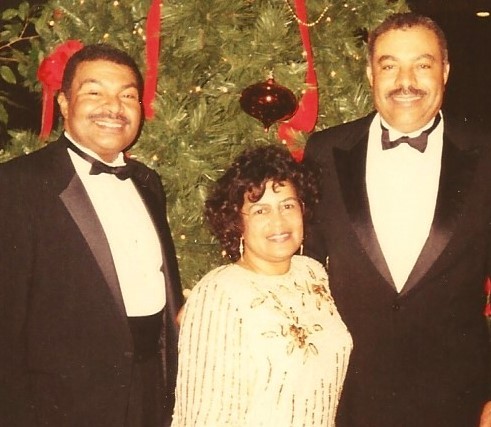
The Paris Family (l-r), Wendell, Alice, and her husband George. All once lived at the Federation’s Epes, Alabama Training Center.
This indomitable team also created the outlines of what would become the Training Center’s calling card—agricultural demonstration projects—both livestock and vegetable crops. Small family farmers all over the South would visit the Training Center to learn how to more economically and efficiently plant and rotate their crops, manage their livestock, and generally become more productive. The Training Center would also eventually encompass a large conference center, complete with a kitchen and cafeteria; dormitory facilities to house up to 80 trainees; a business center to reproduce educational materials; and offices to accommodate the growing staff. It became the foundation stone of the Federation’s operations and remains so to this day.
Tenn-Tom Waterway—the Federation Flexes its Muscles
An advantage to having staff live in the community they were working for was their ability to stay alert to new developments.One of the Federation’s earliest big wins resulted from a federal dam project on a waterway that flowed right by its doors. Soon after the Federation’s staff relocated to the Training Center, the federal government announced a multi-billion-dollar, multi-year public works project that would create a series of locks, dams, and channels over a 234-mile course through Mississippi and Alabama to connect the Tennessee River with the Tombigbee River and the Port of Mobile. The new Tenn-Tom Waterway would create an alternate route for barge traffic to flow from the middle of the country to the Gulf of Mexico. Ostensibly, the project was an extension of the War on Poverty, but when President Nixon announced his plans to put $1 million in his 1971 budget proposal to initiate the project, many saw it as a political move to shore up his support in key Southern states. Nevertheless, after nearly a two-year delay, the project broke ground in December 1972.
Curiously, even with the federal government’s involvement, there seemed to be no set asides for minority participation in the project. Members of the Federation staff realized that the opportunity for jobs and job training for many of their members was passing them by, as the Army Corps of Engineers was importing labor from states as far away as Iowa and Indiana to work on the project, despite the fact that the waterway cut right through some of the most economically depressed areas of the country. In January 1974, the Federation convened a conference to discuss the matter at its Training Center site. From that meeting emerged the Minority Peoples Council on the Tennessee Tombigbee Waterway, which would ultimately be successful in lobbying the federal government’s Corps of Engineers, Labor Department, and the Office of Federal Contracts Compliance, to create an affirmative action plan that led to the training and employment of hundreds of Black construction workers from the region to work on the project through its 1984 completion.

Wendell Paris standing on a bridge traversing the Tenn-Tom Waterway, a multi-billion federal project for which Paris, on behalf of the Federation, secured hundreds of jobs for local Blacks.
This was an incredible success for the Federation, still in its early growth years. The Federation’s Wendell Paris chaired the Minority Peoples Council, and his involvement in negotiating with government officials provided just the kind of credibility the Federation needed to convince local Black residents still on the fence about cooperatives that the Federation was bringing about significant positive economic change to the region.
Connecting the Dots – Civil Rights and Economic Justice
The Training Center also provided the Federation with a large space to hold mass meetings of its members. Since it became fully operational in 1972, the Federation has held every one of its annual meetings at its Epes Training Center, hosting an array of celebrities and politicians, some of whom had never stepped foot into America’s Black Belt before.
If any proof were needed to demonstrate that the Federation and economic justice were the next step in the long civil rights movement, one need only look at the speakers the Federation invited to its annual meetings in the early days of its development. At its first meeting in March 1968, only months after the Federation was formally incorporated (August 1967), Charles Prejean himself served as the primary speaker. Once the Federation found its footing, such civil rights icons as Mississippi’s Fannie Lou Hamer, the SCLC’s Ralph David Abernathy, and Georgia state senator and former SNCC Communications Director Julian Bond provided the keynote addresses for the years 1969, 1970, and 1971, respectively. All of these luminaries understood that the work of economically empowering low-income minority farmers was essential to the political empowerment that each had dedicated their lives to. Their star power helped give credibility to the Federation’s efforts and drew even more cooperatives into the Federation’s orbit.

Then-Georgia State Representative Julian Bond was the featured speaker at the Federation’s third annual meeting in 1971. Pictured from left to right are Federation Board members Gonze Twitty (SC) and Woodrow Keown (AR); Executive Director Charles Prejean; Julian Bond; and Board President Arthur Harris (TN).
For its 1972 annual meeting, the Federation invited as its keynote speaker the recently elected African-American Congressman Parren Mitchell of Maryland, a founding member of the Congressional Black Caucus and brother to the NAACP’s legendary lobbyist Clarence Mitchell, Jr. The following year, the Reverend Jesse Jackson filled the keynote slot. More than any other social justice organization operating out of the South at that time, the Federation had the foresight to connect its struggle for economic justice for some of America’s poorest rural citizens with those fighting for the same principles for the country’s urban poor.
By the mid-1970s, the Federation was serving more than 130 co-ops in 14 states, with most consolidated in the Deep South states of Louisiana, Mississippi, Alabama, Georgia, Florida, and South Carolina. In addition, the concept of state associations, also part of the incorporators’ vision, began taking shape in many of these states. (Today, the Federation’s member state associations continue to operate in AL, GA, FL, MS, and SC.) The Federation saw its role as a regional coordinator of its members’ interests, particularly at the federal level. The Federation could help attract federal monies and monitor federal legislation and lobby for advantageous provisions for low-income minority farmers with the federal government. The role of the state associations was to discern the needs of cooperatives and co-op members in their respective states and to lobby for assistance to meet those needs with the Federation and with public and private funding sources at the state level. Their role involved spearheading state legislative initiatives and lobbying for legislation at the state level that would, if not an advantage to their member cooperatives, at least put them on a level playing field with the larger farms and agribusinesses that were beginning to dominate the rural landscape. The state associations also provided the needed local link that the geographically dispersed Federation might have found hard to achieve otherwise. Member co-ops were required to join both their state association and the Federation. State elections were held annually to select a statewide representative to serve on the Federation’s board of directors.
NEXT: More about the Panola Land Buying Association, its deep roots in the 1960s civil rights movement, and its unlikely success in securing land and a future for its residents as well as for the Federation.
Previous Blogs on The Federation and its 50 Years of Courage, Cooperation, Commitment & Community:
#1. http://blog.notbemoved.com/post/167100925831/lighting-a-candle-instead-of-cursing-the-darkness
#2. http://blog.notbemoved.com/post/167392921041/the-start-of-the-southern-black-cooperative
#3. http://blog.notbemoved.com/post/167664317156/congressman-john-lewis-ga-offers-tribute-to-the
#4. http://blog.notbemoved.com/post/169972785176/carol-prejean-zippert-the-creative-voice-of-the
#5. http://blog.notbemoved.com/post/170841167581/the-great-society-helps-to-jump-start-the
#6. http://blog.notbemoved.com/post/172442025321/federation-gets-off-to-a-strong-start-thanks-to
#Federation 50th#Federation of Southern Cooperatives#Panola Land Buying Association#Rural Training and Research Center#Tenn-Tom Waterway#Wendell Paris#Alice Paris#George Paris#Charles Prejean#Julian Bond#Tennessee-Tombigbee Waterway#Economic Justice#Civil Rights#Jesse Jackson#Parren Mitchell#Clarence Mitchell#Congressional Black Caucus#Fannie Lou Hamer#Ralph David Abernathy#Corps of Engineers#Minority Peoples Council
0 notes
Text
Federation Gets Off to a Strong Start Thanks to Visionary Leadership
Sixth in a series about the Federation of Southern Cooperatives
When the group of 22 individuals signed on to the new Federation’s Articles of Incorporation and Bylaws in 1967, their first official act was to choose a leader. Charles Prejean, was an obvious choice. Because of his growing role in cooperative development in Louisiana, Charles Prejean had been invited to be present both at the Mt. Beulah meeting and at the birth of the Federation in Atlanta. Others who would become dynamos of the Southern Cooperative Movement were also in attendance, including John Zippert, Prejean’s sister Carol, Estelle Witherspoon, G. L. (Gonze) Twitty, and Lewis Black.

Charles Prejean in the 1970s, explaining the mission and purpose of the Federation of Southern Cooperatives.
Charles Prejean became an original signatory to the Articles of Incorporation and despite his relative youth—he was only 26 years old at time of the Federation’s formation—he was chosen by the other signatories to serve as the president of the newly formed Board of Directors. It was a prescient choice. Prejean would lead the organization—first as President, then as Executive Director—through its formative and spectacular growth years, as well as through some of its most difficult days. For the next 17 years, Prejean would be at the helm, securing federal grants from the OEO and other federal agencies, attracting substantive funding from leading foundations, and inviting churches and other charitable organizations to help aid the Federation’s social welfare mission.
The Federation’s Mission and Purpose
When Prejean and others drafted the Federations Articles of Incorporation and Bylaws, they spent a substantial time determining the newly forming organization’s purpose statement, what we would now call its mission. The 34 long lines of text—presented as a single sentence—provide a short course in cooperative development. Some excerpts follow.
The purpose for which the Federation is organized are:
for primary and mutual benefit of patrons of the association as ultimate consumers;
to promote region-wide programs and institutions for the training of persons interested in the formation and development of all types of cooperatives;
to act as a clearing house and data bank of information relating to the different types of cooperatives;
to make technical and financial resources available to existing cooperatives and to persons wishing to organize a cooperative or association of cooperatives;
to aid cooperatives in ascertaining alternative means of supply and distribution;
to engage in research relevant to economic development or cooperative expansion;
to serve as a clearing house for potential resources, financial assistance and technical help for cooperatives;
to promote the organization of state associations of cooperatives;
to assist, defend and protect the cooperative movement;
to engage in any activity in connection with the marketing or selling of agricultural or manufactured products of its members;
to finance by loan, grant or purchase any of the aforementioned activities.
Clearly the drafters were thinking big, expecting their small group of originating cooperatives to expand in scope while also assuming that the concept of agricultural and handicraft cooperatives and credit unions would catch on as a way for low-income farmers and rural people to create their own institutions, improve their economic situations, and provide meaningful employment for themselves and their communities. It was a revolutionary concept that shattered the stereotype of the shiftless Southern Black agricultural worker who needed an overseer to ensure that any work got done. Here, those very people were taking their destinies into their own hands, working cooperatively for a better future, and inspiring others to do the same.
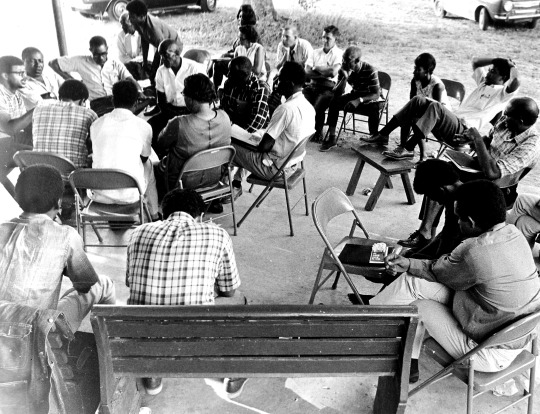
A caucus of members meet to discuss policy direction for their cooperative at a Federation annual meeting in the 1970s.
The incorporators’ grand vision paid off. In 1968, OEO came through with its first grant of nearly $600,000. “That really was the take-off point for the Federation of Southern Cooperatives,” Prejean would later say. Within a year, the Federation’s membership base had more than doubled, with 45 member-cooperatives, serving about 10,000 low-income families. By the end of 1971, that number had jumped to 110 cooperative members—exactly five times the number of initial incorporators—serving approximately 30,000 families.
A Funding Source to Support Struggling Co-ops
One issue that Prejean identified early in his tenure was the fact that much of the federal and foundation funding was directed for specific initiatives or earmarked for only certain types of cooperative development support, like providing technical advice or training. There were no funds to assist financially struggling cooperatives meet their bottom lines. “The response to the Federation has been great,” he wrote to Leslie Dunbar, former head of the Southern Regional Council who was by now running the Field Foundation, “but I am beginning to become frustrated because we have resources to help with so few of the problems of cooperatives.”

The logo of Southern Regional Council–a 1940s civil rights organization that helped organize the Federation of Southern Cooperatives.
The solution was to create a revolving funding mechanism that would enable co-ops to get grants or loans directly from their own institution rather than having to attempt to obtain loans from banks or other established financial institutions unlikely to loan funds to an organization run by low-income people. In January 1969, the OEO provided a $500,000 grant to the Federation to establish the fund, which became the Southern Cooperative Development Fund (SCDF). At Prejean’s recommendation, the Federation board recruited Father McKnight to become the director of the new entity. The Federation had authority to appoint a majority of the board members to oversee the fund’s operations. Within a few years, SCDF had made loans totaling almost $3 million to Federation member-cooperatives for various operational improvements. Additionally, thanks to grants from the federal government and various foundations, SCDF’s assets had grown to nearly $8 million Thus, SCDF became the financier of the burgeoning Southern cooperative movement, while the Federation provided on-site consulting services as well as some limited grant assistance to ensure its member-cooperatives’ success.
How it All Worked
In the 1971 annual report, Prejean provided a number of success stories from the Federation’s various enterprises. These vignettes offer a glimpse into the fledgling Federation’s scope and impact:
At Grand Marie Co-op, Sunset, Louisiana, the co-op completed its fifth season (1970-71 crop) in April with a small operating profit of $1,800—the first time the co-op was able to complete a season with profit. This was achieved on a sales volume of a quarter of a million dollars, 55,000 bushels shipped. The success would have been impossible without a loan of $96,000 from the Southern Cooperative Development Fund and the technical assistance and training inputs of the Federation.
In the spring of 1971, with the assistance of the Federation’s Marketing Specialist and a field consultant, the Sea Island Farmers Co-op, Frogmore, South Carolina, was able to market over $80,000 in tomatoes for 45 members at a net operating profit of $13,000. This year marked the first time [that] members stayed together to make a truly cooperative effort to market their crop. Farmers received an average of $2.62 a bushel for their tomatoes, which is more than in past seasons. They are expecting a small patronage refund while re-investing the remainder of their surplus in new facilities to improve efficiency.

At Miss-Lou Farmers Co-op, operating in the four southwest Mississippi counties and two Louisiana parishes, the co-op had sales of cucumbers and peppers in 1970 of $63,425. This was a 176% increase over the 1969 crop of $23,000. Over the past four seasons of its existence, the co-op has consistently fought for higher prices for its members. For the period from 1967-1971, the co-op raised the price per hundred pounds paid to the farmers for cucumbers by $0.95 or 35.6% in comparison to its competitor’s prices. On an average yield of 7,000 lbs. per acre, this is an increase of $66.50 per acre to growers. On peppers, the co-op has caused the price to increase from 6.5¢ in 1969 to 8.5¢ in 1971, an increase of 23.4% over the past three years. This year as a result of [the Federation’s] membership training sessions, members in two communities purchased their own cucumber grading machines to increase their flexibility and advantage in marketing.
These brief glimpses into the operations of such modest cooperative enterprises demonstrate the power of the Federation’s involvement. By providing training, advice on marketing, crop selection, and cooperative governance, the Federation was able to smooth out some of the rough patches that each cooperative had experienced and help move the co-ops for the first time to profitability. It is also apparent that by combining the output of various individual farms (as in the Sea Island and Miss-Lou examples), the local co-op was able to force the price point for the products to a higher level, putting more money into the individual farmers’ pockets while also generating a margin for the cooperative.
The Federation also played a critical role in advising co-ops on just how the cooperative enterprise was supposed to work: the role of the Board of Directors in the setting of policy; the role of the co-op manager in day-to-day operations; the importance of the one-member/one-vote democratic governance structure. Federation staff also served as sounding boards for inevitable disagreements that would arise about these finer points of cooperative operations.
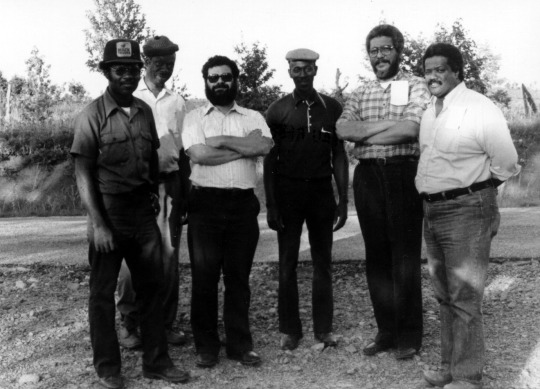
Charles Prejean (second from right), along with Federation staff members John Zippert (sunglasses) and Ralph Paige (right) visit with local farmers to discuss their needs.
By 1971, the Federation was receiving praise from important boosters. At its annual meeting that year, the American Institute for Cooperatives hosted CLUSA’s recently retired president and former U.S. Congressman Jerry Voorhis, who honored the Federation for “doing a job of outstanding importance” for the rural poor. Also that year, the Field Foundation’s Dunbar wrote Prejean to say that “all of us at Field are greatly impressed by what the Federation has accomplished.”
It is instructive to note that of the 110 members in 1971, 25 of them were credit unions with a combined asset total of more than half a million dollars. That year, more than 2,500 loans had been made to their low-income members. This was micro-lending before the term had been coined, and it is a testament to both McKnight’s and Prejean’s vision that they had the foresight to understand that even small loans could make a big difference in the lives of low-income people with limited access to traditional funding sources.
Unfortunately, even in 1971, Prejean expressed concern over the unfriendly views that the credit union regulatory body, the National Credit Union Administration (NCUA) had toward small, low-yield credit unions with volunteer staff like the ones the Federation was helping to create and sustain. “The Federation has developed with (its) member credit unions a critique of the present discriminatory policies of the NCUA toward low-income organizations,” Prejean wrote. This issue would haunt the Federation’s credit union members for years, causing some to merge and others to shutter their doors.
#Charles Prejean#Federation 50th#NCUA#Federation of Southern Cooperatives#John Zippert#Estelle Witherspoon#Lewis Black#Gonze Twitty#Carol Prejean#Leslie Dunbar#NCBACLUSA#Field Foundation#Jerry Voorhis#American Institute for Cooperatives#credit unions
0 notes
Text
The Great Society Helps to Jump-Start the Federation
Fifth in a Series on the Federation of Southern Cooperatives
Washington, DC loves political drama, whether it’s delivered daily through the news media or in the form of a retrospective. As we have enough of the former lately, it is instructive to have one of America’s most tumultuous periods served up to us through Arena Stage’s production of The Great Society, the newest play from Robert Schenkkan, whose All the Way won the Tony Award in 2014 and went on to be a blockbuster HBO TV film. All the Way chronicles the first year of LBJ’s presidency, from the assassination of John F. Kennedy to Johnson’s coronation as the Democratic nominee for President at the 1964 convention in Atlantic City. The Great Society picks up the thread right after that historic moment and carries us through the next chaotic four years of Johnson’s administration: through Selma, the passage of the Voting Rights Act, the creation of the Medicare and Medicaid programs, the Watts riots, the Black Power movement, and, tragically, the escalation of the Vietnam War, which would sap the energy and the funding from Johnson’s grand vision of creating an American “Great Society.”

Arena Stage’s The Great Society. Art work by Richard Davies Tom.
Though the play (and the period) deserve their own epic review, I use the currency of the play’s premier in Washington to introduce the next section of my series on the Federation of Southern Cooperatives. It was, after all, Johnson’s Great Society program that helped launch the Federation 50 years ago and which funded many of its most innovative early projects before the program fell out of favor with Congressmen and local politicians, who wanted to control the federal funding project and use it for patronage rather than for serious improvement. Here is the Federation’s history in summary form detailing its connection to Johnson’s great achievement and how it helped provide the foundational support for an enduring cooperative legacy.
LBJ’s Great Society and War on Poverty
The 1960s were a time of great optimism, despite the social upheaval. President John Kennedy had committed to putting a man on the moon by the end of the decade. President Lyndon Johnson, in his first Inaugural Address less than two months after Kennedy’s assassination, declared a War on Poverty and the creation of a Great Society that would, he hoped, rival President Franklin Roosevelt’s New Deal. There was the belief that if enough resources and focus could be brought to an endeavor, all things were possible and any problem could be solved, even the gnawing, persistent poverty that plagued much of the South.
In 1965, the Office of Economic Opportunity (OEO) was formed—a result of Johnson’s massive legislative push the year before, which included the Civil Rights Act of 1964, the Criminal Justice Act of 1964, the Food Stamp Act of 1964, and, of course, the Economic Opportunity Act of 1964. [The Voting Rights Act—the crown jewel of Johnson’s legislative achievement—would come in 1965.] Nearly a billion dollars were earmarked for the fight against poverty. Funds would be distributed through Community Action Programs, some of which could be independent of state control so that funds could go directly to worthy projects—even experimental ones—that held the promise to raise the economic prospects for those most impoverished. The OEO legislation called for “maximum feasible participation” by the poor themselves—a clear signal that this effort was meant to be something other than business as usual. A special carve-out was provided in the legislation for cooperatives. Specifically, under Title III—Special Programs to Combat Poverty in Rural Areas, the law stated:
The Director is authorized to make loans to local cooperative associations furnishing essential processing, purchasing, or marketing services, supplies, or facilities predominantly to low-income rural families.
Many community organizers from the established civil rights organizations—SNCC, CORE, SCLC and even the NAACP—took hold of this language and began forming cooperative institutions in their areas that they believed could bypass the existing White stranglehold over agricultural production and marketing, as well as its lock on political patronage. The hope was that cooperative institutions would open up new opportunities for the impoverished Black citizens while educating them about basic principles of democratic participation as infused in the cooperative model. Co-ops would become, in the words of SCLC’s Albert Turner, “the economic arm of the civil rights movement.” [It was Turner who would as a catalyst for the Selma to Montgomery March by insisting that the murder of Jimmie Lee Jackson be publicly addressed.]
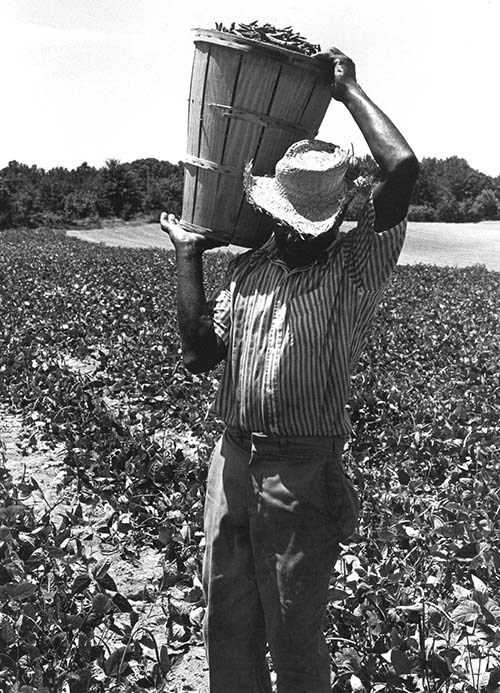
Work on a Federation-member rural agricultural cooperative in the 1970s.
Thanks to the Economic Opportunity Act of 1964, millions of federal dollars began flooding into the South beginning as early as 1965. The beneficiaries of some of these funds were newly formed cooperatives that had been struggling to find a foothold. Such organizations as the Southwest Alabama Farmers Cooperative Association, Ezra Cunningham’s organization, and the Southern Consumers Cooperative—McKnight’s and Prejean’s initiative, received grants for a variety of “demonstration projects” to prove that their programs could, in fact, work to improve the conditions of the rural poor.
The Federation was a direct beneficiary of this early War on Poverty largesse. In addition, its initial funding came from the Cooperative League of the USA (CLUSA)—a forerunner of today’s National Cooperative Business Association—in the form of a $35,000 grant which derived from CLUSA’s own larger OEO-funded cooperative development project. [Additional start-up funding was provided by the Aaron Norman Fund and the New York Foundation.] Indeed, CLUSA’s Merlin Miller and Chuck Ihlenfeld were present when the idea for the Federation was hatched at Mount Beulah.
More front-end funding and encouragement came from the International Self-Help Housing Association (ISHHA), a Quaker-initiated organization; from the Southern Regional Council, a White progressive group working for equality in Southern race relations which by this point was running the important voting rights initiative, the Voter Education Project; and from the National Sharecroppers Fund, an advocacy group for sharecroppers and tenant farmers that grew out of the Southern Tenant Farmers’ Union. Thus, the various threads of the progressive movement—cooperatives, religious, civil rights and economic justice groups—coalesced to form what would become a potent mechanism for the empowerment of some of the least powerful citizens in America. The next fifty years would be a thrilling, if bumpy, ride for the Federation.
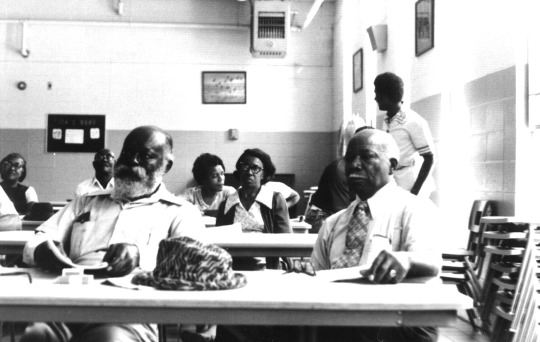
An early Federation training session (1970s) for Black farmers.
Uphill Battle
It is instructive to consider that, aside from the Federation’s initial explosive growth and the federal and foundation funding it attracted in the late 1960s, the organization was fighting an uphill battle almost from the start. Two major factors ensured this Sisyphean struggle would continue: the lack of political will to continue the War on Poverty and the all-pervasive and blatant discrimination against Black farmers practiced by Southern federal government employees who were accommodated by their superiors all the way up the line to Washington, DC.
First, the Nixon administration, which took over the reins of federal government in 1969, began systematically dismantling President Johnson’s Great Society programs, starting with the OEO. Nixon put young Illinois Congressman Donald Rumsfeld in charge of the agency. Rumsfeld quickly spun-off the most popular programs to other agencies (Job Corps to the Department of Labor; Head Start to HEW), thus weakening the OEO’s cabinet-level status. Rumsfeld also started a process of defunding some of the more successful programs or forcing expensive evaluations of their poverty-fighting methods. In early 1973, at the start of Nixon’s second term, the President further gutted the agency by removing any budgetary allotment for Community Action Programs—the very ones that were funding the Federation’s grassroots cooperative organizing efforts and those of its members. “After more than 7 years … further federal spending on behalf of this concept, beyond the $2.8 billion which has already been spent on it since 1965, no longer seems necessary or desirable,” Nixon told Congress that year.
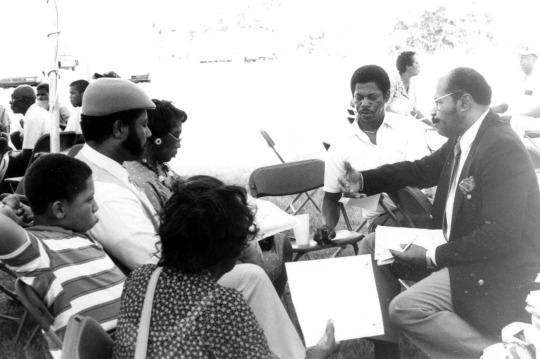
Discussion at one of the Federation’s earliest Annual Meetings (1970s), just as the Nixon Administration was busy cutting back on the War on Poverty.
The OEO continued to limp along in various guises until another conservative reformer, President Ronald Reagan, broke it up completely in 1981. Reagan would later cynically—though cheerfully—say in his weekly radio address, “In 1964 the famous War on Poverty was declared and a funny thing happened. I guess you could say, poverty won the war.” It wasn’t funny to those in the rural areas of the Deep South who were trying to make it on less than $1,000 a year. Fortunately for them, the Federation had begun to diversify its funding sources so that even in the Nixon years, significant dollars came from a variety of federal and state agencies, as well as foundations and church-based groups.
By 1973, for example, only 5% of the Federation’s $1.5 million income was derived from OEO funding. Significantly greater amounts came from the U.S. Commerce Department’s Office of Minority Business Enterprise ($613,000) and the Department of Health, Education, and Welfare (nearly $300,000 for jobs training programs and $110,000 for the Black Belt health care initiative). Much of the rest of the funds came from various foundations and church groups, including the Rockefeller Brothers Fund ($150,000), the Ford Foundation ($92,000), and the Field Foundation ($77,700). An impressive $24,000 was raised from staff contributions.
For more information about the War on Poverty and how it played out in the rural South, consult Susan Youngblood Ashmore’s Carry It On: The War on Poverty and the Civil Rights Movement in Alabama 1964-1972
Next: Charles Prejean, the Federation’s first leader, jump starts the rural cooperative movement in the South.
#Federation 50th#Federation of Southern Cooperatives#LBJ#TheGreatSociety#Richard Nixon#SargentShriver#Charles Prejean#NCBA#CLUSA#NCBA/CLUSA#Office of Economic Opportunity#Susan Youngblood Ashmore#Carry It On: The War on Poverty and the Civil Rights Movement in Alabama 1964-1972
0 notes
Text
Carol Prejean Zippert – the Creative Voice of the Federation
Fourth in a Series on the Federation of Southern Cooperatives
Every movement has its poet, its chronicler, it’s creative voice. For the Federation of Southern Cooperatives, that voice—for its entire 50 years—has been Carol Prejean Zippert. As a young girl, Carol became enthralled with Father McKnight and his organizing for black economic empowerment. She and her brother, Charles (who would become the Federation’s first Executive Director), were present when the Federation was incorporated. And she would be part of the Federation’s fabric for its entire first 50 years—and is still active in the organization’s life and work. [She now serves as President of the Friends of Greene County Employees Federal Credit Union, a Federation member.]

Carol Prejean Zippert in the 1980s, about the time she began writing poetry for and about the Federation of Southern Cooperatives.
At some point in the 1980s, Carol began writing poetry, some of it focused on the Federation and its work. Her poems became regular features in the Federation’s annual reports and she would be a welcome speaker at the co-op’s annual meeting, reading her most recent creation to an enthralled membership.
Included below is the poem we chose to lead off the 50th anniversary commemorative book: One Day We Created a New Family. It perfectly summarizes the why and the how behind the Federation’s long and storied history. Following the poem is a brief biographical sketch of Carol and her husband of more than 50 years, activist and long-time Federation employee John Zippert. Be inspired!
One Day We Created A New Family
By Carol Prejean Zippert
One day when we needed
new birth to help us discover
our history, live our culture
and pursue our justice,
we created a new family.
One day when we needed
to reclaim our dignity and respect,
when we needed to lift our heads
and open our eyes and minds,
we created a new family.
One day when we needed
to find our sisters and brothers
in struggle and form a bond
for our mutual survival
we created a new family.
One day when we needed
to save our children
to extend their lives and learnings,
when we needed to prepare them
as community-directed leaders,
we created a new family.
One day when we needed
to rediscover God’s earth
and all its gifts, to appreciate the soil,
waters, all living creatures and resources,
we created a new family.
One day when we needed
to save our land, build our houses,
provide for our healthcare,
secure our right to vote,
and assert our political leadership,
we created a new family.
One day when we needed
to form a more responsive society,
when we needed to secure more
loving communities,
we created a new family.
One day when we needed
a new family
for ourselves and for our children,
for our communities and for our nation,
One day when we needed to celebrate God’s world
We created a new family,
We created the Federation –
the FSC family.
One day we needed
a new family.
©2017 Carol Prejean Zippert
Carol’s two volumes of poetry, I Don’t Want to Be Rich, Just Able and Meeting Myself ‘Round the Corner, both published by NewSouth Books (Montgomery, AL) can be ordered by writing to her at P.O. Box 82, Eutaw, Alabama 35462.
John and Carol (Prejean) Zippert
John and Carol met while working in the civil rights and cooperative movement in southwest Louisiana. John was a volunteer and later field staff with the Congress of Racial Equality in St. Landry Parish, Louisiana. John was working on registering minority voters, integrating public accommodations and helping sweet potato and vegetable farmers to develop a cooperative to market their produce.
Carol was working with the Southern Consumers Cooperative while attending the University of Southwest Louisiana. She participated in a special program to study cooperatives and credit unions nationally and internationally in Canada and Turkey.
When John and Carol decided to get married in 1967, they had to sue the State of Louisiana to remove its miscegenation statute to allow them to get a marriage license. Partners in both life and the pursuit for racial, social, and economic justice in the U.S. South, John and Carol (Prejean) Zippert continue to embody the principles and priorities of the two movements that shaped their lives—the civil rights movement and the cooperative movement.
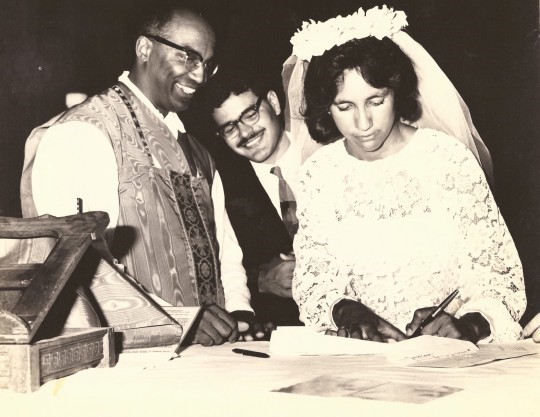
Rev. A. J. McKnight after officiating at the marriage of John Zippert and Carol Prejean--the first such marriage in the state of Louisiana after the U.S. Supreme Court ruled in Loving v. Virginia that bans on interracial marriage were illegal.
Father A. J. McKnight first kindled the couple’s passion and commitment to the cooperative movement. The same year they were married, the Federation of Southern Cooperatives was chartered. John and Carol were involved as community organizers with the cooperatives and credit unions and participated in the meetings that resulted in the formation of the Federation. John and Carol’s lives progressed in parallel with the mission of the Federation and the growth of the cooperative movement in the South.
For nearly five decades, John has worked for the Federation. For the past quarter century, he has served as the Director of Program Operations for the Federation at its Rural Training and Research Center in Epes, Alabama, where he has promoted cooperative economic development for low-income and minority people in ten Southeastern United States. In the wake of Hurricanes Katrina and Rita, John expanded the Training Center’s reach to include relief work, enlisting cooperatives to help individuals, families, and other co-ops to recover and rebuild along the Gulf Coast.

John Zippert speaking on behalf of the Federation of Southern Cooperatives in the 1980s.
During his career at the Federation, John has trained staff, mentored countless young people and designed programs to further sustainable small farming and cooperative development. The Federation honored John’s dedication with its Staff Award in 1977, 1978 and 1996.
John serves on the board of numerous state and national organizations, including the Rural Coalition, Rural Development Leadership Network, Alabama New South Coalition, Alabama Black Belt Commission, and others. John has been involved in advocacy and public policy development for family farmers, as well as for rural and cooperative development. He also assisted hundreds of African-American farmers in filing successful claims in the Pigford Class Action discrimination lawsuits.
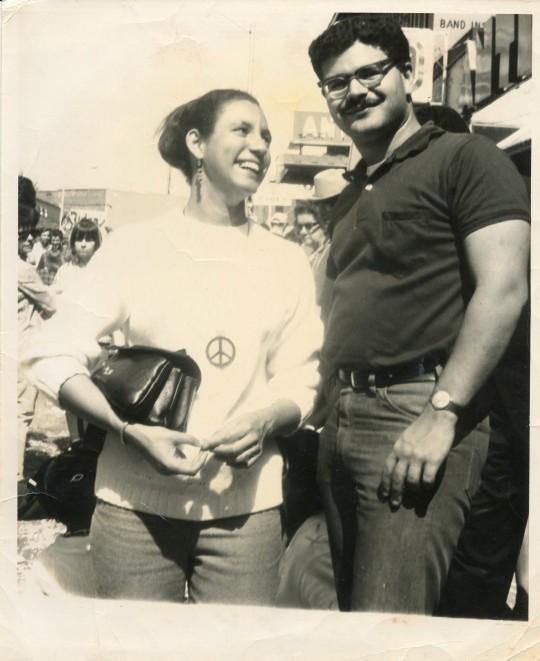
John and Carol in the late 1960s.
In 1985, Carol earned her Ph.D. in Educational Leadership, Supervision, and Curriculum Development from the University of Alabama, Tuscaloosa. As a self-described “community worker,” she dedicated five decades to building leadership and developing co-ops with the Federation—where she continues to volunteer—as well as supporting grassroots community groups in their work to achieve social transformation. Carol has served as an adjunct research professor and resource specialist for Tuskegee University’s Community-Based Youth Partnerships. She has been involved with the 21st Century Youth Leadership movement since its inception in 1986 and continues to serve on its board.
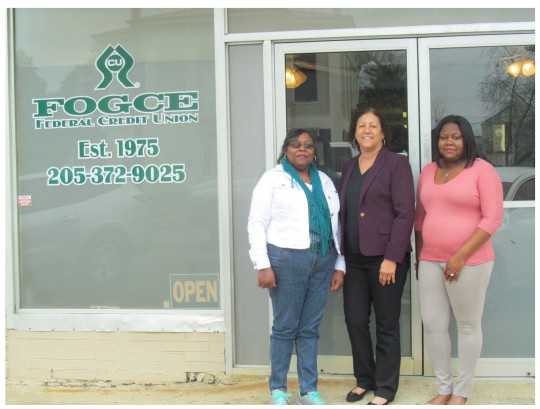
Carol Prejean Zippert (center) serves as president of Friends of Greene County Employees Federal Credit Union. She is standing in front of the credit union’s new headquarters on the Eutaw (AL) town square with manager Joyce Pham (l) and accounting clerk Kiera Epps (r).
Carol is also president and founder of the Federation of Greene Country Employees (FOGCE) Federal Credit Union. Under her leadership, low-income people of one of the poorest counties in the U.S. built a credit union that has accumulated more than $1.4 million in assets. In addition, Carol’s poetry and leadership in cultural organizations such as the Black Belt Community Foundation and the Greene County Society for Folk Arts and Culture strengthen connections and trust among people, their co-ops, and their communities.
Since 1985, John and Carol have together published the Greene County Democrat Newspaper, a weekly publication to inform and educate their primarily African-American community.

John and Carol Zippert (center) at the Co-op Hall of Fame induction ceremony in May 2017 at the National Press Club in Washington, DC.
In 2017, the couple was inducted into the Cooperative Hall of Fame, the highest honor awarded to cooperative activists, sponsored by the Cooperative Development Foundation and the National Cooperative Business Association.
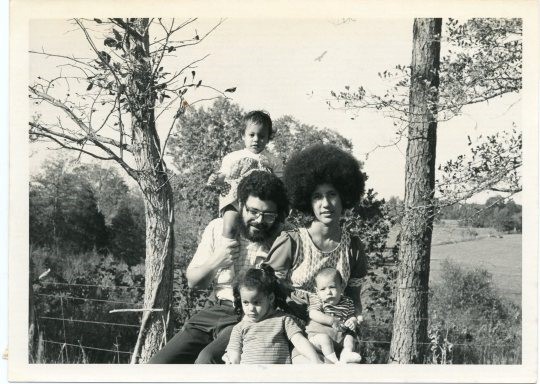
John and Carol with their three children at the Federation’s Rural Training Center in Epes, Alabama, in the 1970s.
#Carol Prejean#Carol Prejean Zippert#John Zippert#Federation of Southern Cooperatives#Federation50th#Loving v. Virginia#Pigford Lawsuit#OneDayWeCreatedANewFamily#Greene County Democrat#Father McKnight#Rev. A. J. McKnight#Southern Consumers Cooperative#Congress of Racial Equality#CORE#Charles Prejean#Cooperative Development Foundation#National Cooperative Business Association#NCBACLUSA#CoopHeroes
0 notes
Text
Congressman John Lewis (GA) Offers Tribute to the Federation’s Legacy
Third in a Series on the Federation of Southern Cooperatives
At its 50th Anniversary celebration in Birmingham, Alabama, earlier this year, Congressman John Lewis provided a fitting tribute to the Federation of Southern Cooperatives and its essential contribution to the economic justice and civil rights in the rural South during the past 50 years. I was fortunate to be present at the celebration and (a little belatedly) realized I could capture the moment on video if I acted quickly. What follows is my attempt to preserve for history Lewis’s powerful remarks of congratulation and encouragement to the Federation’s members and staff. Also included below is the tribute Lewis provided for our commemorative booklet.
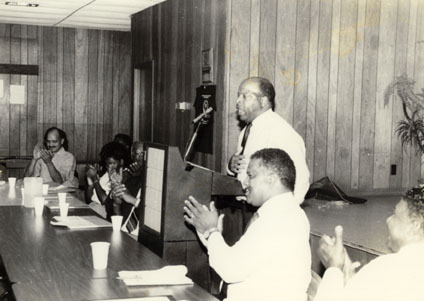
Congressman John Lewis addressing a Federation Annual Meeting in the 1980s. Lewis has had a long and storied history with the Federation.
Congressman Lewis had direct involvement in the Federation’s start, as he notes early in his remarks (which we enter “in media res” as they say), making a “small grant” to the fledgling organization while working for the Southern Regional Council as part of the Community Organization Project. During this short video, Lewis also tells his now-famous (and hilarious) chicken story. Take a look and a listen …
youtube
In Part II of his presentation (less than 2 minutes), Congressman Lewis exhorts the audience to “never give up” and to continue supporting the Federation’s mission and work. He also gives a nice shout-out to A. Phillip Randolph.
youtube
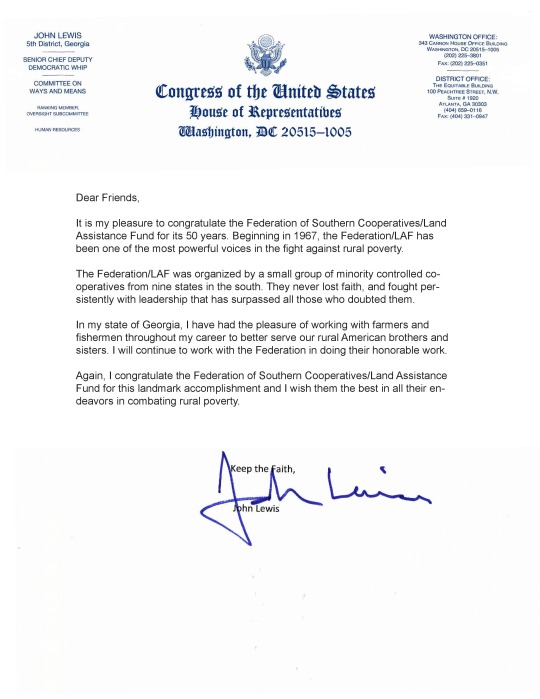
#Federation of Southern Cooperatives#Federation 50th#Congressman John Lewis#John Lewis#Southern Regional Council#Voter Education Project
0 notes